Cross-Cultural Differences in Business Development | Desklib
VerifiedAdded on 2023/06/13
|21
|5425
|493
AI Summary
This paper explores how cultural differences contributed to the failure of Daimler-Benz and Sony Ericsson mergers. It also discusses the impact of cultural differences on business development. The subject is Strategic Marketing Management, and the course code, college/university are not mentioned.
Contribute Materials
Your contribution can guide someone’s learning journey. Share your
documents today.

Strategic Marketing Management 1
STRATEGIC MARKETING MANAGEMENT
Name
Institution
Course
Tutor
City/State
Date
STRATEGIC MARKETING MANAGEMENT
Name
Institution
Course
Tutor
City/State
Date
Secure Best Marks with AI Grader
Need help grading? Try our AI Grader for instant feedback on your assignments.

Strategic Marketing Management 2
Section 1:
An Analysis of the Hofstede Model
Globalization in the current business environment has resulted into a business workf
that is seamless. There are no longer physical barriers that limit communication and
trade. Seamlessness refers to a world where economic, political and cultural barriers
are eliminated. The utmost focus of this essay will be on cultural globalization
analyzing in detail what brings about the different dimensions of culture.
The general idea of culture has different meanings depending on the context in which
it has been used. Schein (2016) defines culture as knowledge and characteristic of a
certain group of people and encompasses religion, music, arts, and cuisine among
other social habits. Geert Hofstede’s theory on the dimensions of culture shall be
particularly of interest in this discussion. He is a renowned author who performed a
study in fifty countries to look at the unique aspects of culture in the different cultures
and rated them on a scale for comparison. Hofstede was able to identify different
categories of cultural dimensions namely; power distance, uncertainty avoidance,
individualism/collectivism, masculinity/femininity and long-term/ short-term
orientation.
Flaws in the Model
Hofstede’s dimension of culture has it its flaws that have been criticized by several
authors. This paper hence analyzes the criticisms as well as identifies other
frameworks that have been used to describe the dimensions of culture.
Geert Hofstede explained different people have different outlooks on life that are
influenced by their cultures. In his power distance cultural dimension, Hofstede
explained that the culture shows great respect for hierarchy. Children in a culture that
has high power distance show great respect for their elders. The same is portrayed in
Section 1:
An Analysis of the Hofstede Model
Globalization in the current business environment has resulted into a business workf
that is seamless. There are no longer physical barriers that limit communication and
trade. Seamlessness refers to a world where economic, political and cultural barriers
are eliminated. The utmost focus of this essay will be on cultural globalization
analyzing in detail what brings about the different dimensions of culture.
The general idea of culture has different meanings depending on the context in which
it has been used. Schein (2016) defines culture as knowledge and characteristic of a
certain group of people and encompasses religion, music, arts, and cuisine among
other social habits. Geert Hofstede’s theory on the dimensions of culture shall be
particularly of interest in this discussion. He is a renowned author who performed a
study in fifty countries to look at the unique aspects of culture in the different cultures
and rated them on a scale for comparison. Hofstede was able to identify different
categories of cultural dimensions namely; power distance, uncertainty avoidance,
individualism/collectivism, masculinity/femininity and long-term/ short-term
orientation.
Flaws in the Model
Hofstede’s dimension of culture has it its flaws that have been criticized by several
authors. This paper hence analyzes the criticisms as well as identifies other
frameworks that have been used to describe the dimensions of culture.
Geert Hofstede explained different people have different outlooks on life that are
influenced by their cultures. In his power distance cultural dimension, Hofstede
explained that the culture shows great respect for hierarchy. Children in a culture that
has high power distance show great respect for their elders. The same is portrayed in
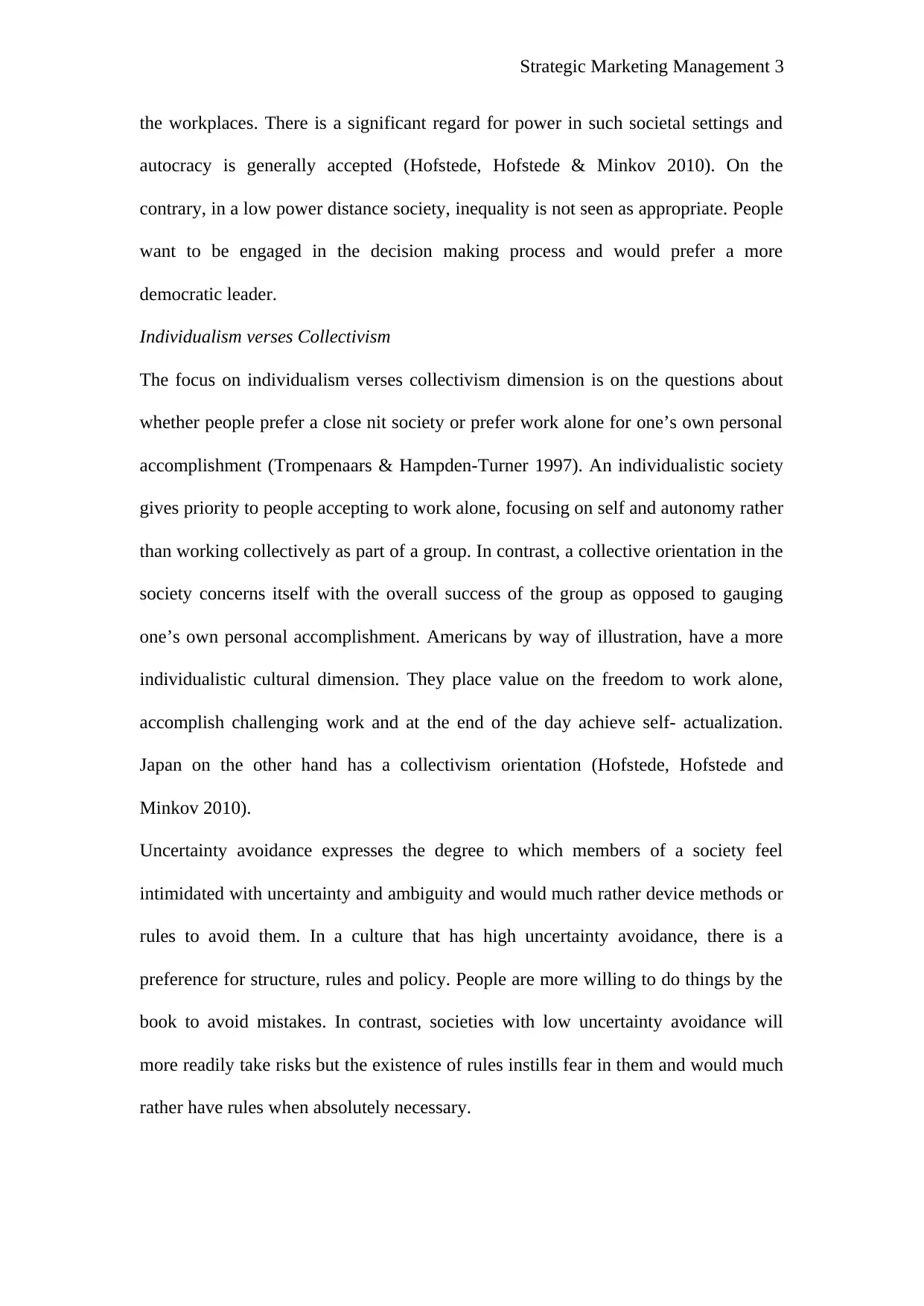
Strategic Marketing Management 3
the workplaces. There is a significant regard for power in such societal settings and
autocracy is generally accepted (Hofstede, Hofstede & Minkov 2010). On the
contrary, in a low power distance society, inequality is not seen as appropriate. People
want to be engaged in the decision making process and would prefer a more
democratic leader.
Individualism verses Collectivism
The focus on individualism verses collectivism dimension is on the questions about
whether people prefer a close nit society or prefer work alone for one’s own personal
accomplishment (Trompenaars & Hampden-Turner 1997). An individualistic society
gives priority to people accepting to work alone, focusing on self and autonomy rather
than working collectively as part of a group. In contrast, a collective orientation in the
society concerns itself with the overall success of the group as opposed to gauging
one’s own personal accomplishment. Americans by way of illustration, have a more
individualistic cultural dimension. They place value on the freedom to work alone,
accomplish challenging work and at the end of the day achieve self- actualization.
Japan on the other hand has a collectivism orientation (Hofstede, Hofstede and
Minkov 2010).
Uncertainty avoidance expresses the degree to which members of a society feel
intimidated with uncertainty and ambiguity and would much rather device methods or
rules to avoid them. In a culture that has high uncertainty avoidance, there is a
preference for structure, rules and policy. People are more willing to do things by the
book to avoid mistakes. In contrast, societies with low uncertainty avoidance will
more readily take risks but the existence of rules instills fear in them and would much
rather have rules when absolutely necessary.
the workplaces. There is a significant regard for power in such societal settings and
autocracy is generally accepted (Hofstede, Hofstede & Minkov 2010). On the
contrary, in a low power distance society, inequality is not seen as appropriate. People
want to be engaged in the decision making process and would prefer a more
democratic leader.
Individualism verses Collectivism
The focus on individualism verses collectivism dimension is on the questions about
whether people prefer a close nit society or prefer work alone for one’s own personal
accomplishment (Trompenaars & Hampden-Turner 1997). An individualistic society
gives priority to people accepting to work alone, focusing on self and autonomy rather
than working collectively as part of a group. In contrast, a collective orientation in the
society concerns itself with the overall success of the group as opposed to gauging
one’s own personal accomplishment. Americans by way of illustration, have a more
individualistic cultural dimension. They place value on the freedom to work alone,
accomplish challenging work and at the end of the day achieve self- actualization.
Japan on the other hand has a collectivism orientation (Hofstede, Hofstede and
Minkov 2010).
Uncertainty avoidance expresses the degree to which members of a society feel
intimidated with uncertainty and ambiguity and would much rather device methods or
rules to avoid them. In a culture that has high uncertainty avoidance, there is a
preference for structure, rules and policy. People are more willing to do things by the
book to avoid mistakes. In contrast, societies with low uncertainty avoidance will
more readily take risks but the existence of rules instills fear in them and would much
rather have rules when absolutely necessary.
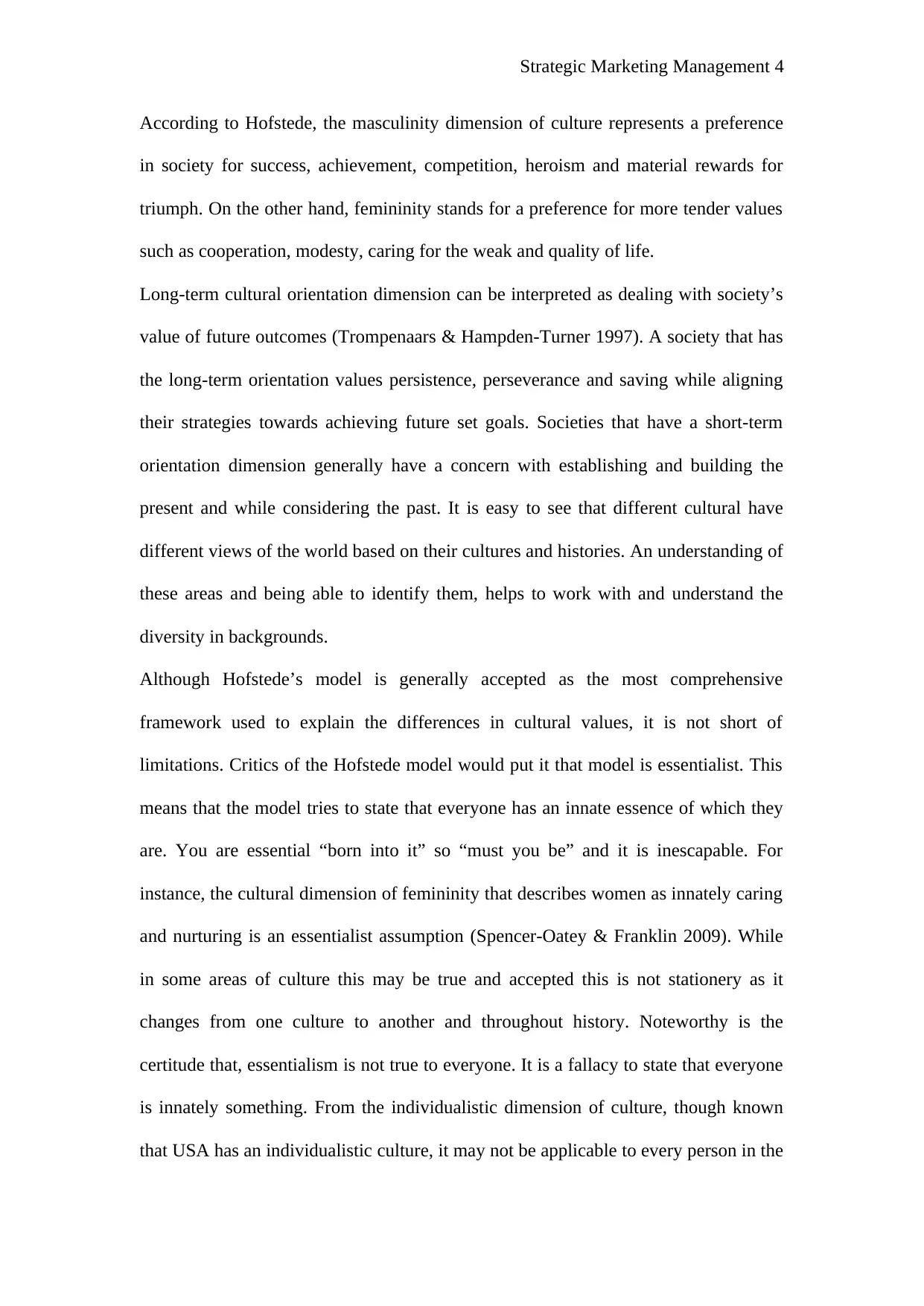
Strategic Marketing Management 4
According to Hofstede, the masculinity dimension of culture represents a preference
in society for success, achievement, competition, heroism and material rewards for
triumph. On the other hand, femininity stands for a preference for more tender values
such as cooperation, modesty, caring for the weak and quality of life.
Long-term cultural orientation dimension can be interpreted as dealing with society’s
value of future outcomes (Trompenaars & Hampden-Turner 1997). A society that has
the long-term orientation values persistence, perseverance and saving while aligning
their strategies towards achieving future set goals. Societies that have a short-term
orientation dimension generally have a concern with establishing and building the
present and while considering the past. It is easy to see that different cultural have
different views of the world based on their cultures and histories. An understanding of
these areas and being able to identify them, helps to work with and understand the
diversity in backgrounds.
Although Hofstede’s model is generally accepted as the most comprehensive
framework used to explain the differences in cultural values, it is not short of
limitations. Critics of the Hofstede model would put it that model is essentialist. This
means that the model tries to state that everyone has an innate essence of which they
are. You are essential “born into it” so “must you be” and it is inescapable. For
instance, the cultural dimension of femininity that describes women as innately caring
and nurturing is an essentialist assumption (Spencer-Oatey & Franklin 2009). While
in some areas of culture this may be true and accepted this is not stationery as it
changes from one culture to another and throughout history. Noteworthy is the
certitude that, essentialism is not true to everyone. It is a fallacy to state that everyone
is innately something. From the individualistic dimension of culture, though known
that USA has an individualistic culture, it may not be applicable to every person in the
According to Hofstede, the masculinity dimension of culture represents a preference
in society for success, achievement, competition, heroism and material rewards for
triumph. On the other hand, femininity stands for a preference for more tender values
such as cooperation, modesty, caring for the weak and quality of life.
Long-term cultural orientation dimension can be interpreted as dealing with society’s
value of future outcomes (Trompenaars & Hampden-Turner 1997). A society that has
the long-term orientation values persistence, perseverance and saving while aligning
their strategies towards achieving future set goals. Societies that have a short-term
orientation dimension generally have a concern with establishing and building the
present and while considering the past. It is easy to see that different cultural have
different views of the world based on their cultures and histories. An understanding of
these areas and being able to identify them, helps to work with and understand the
diversity in backgrounds.
Although Hofstede’s model is generally accepted as the most comprehensive
framework used to explain the differences in cultural values, it is not short of
limitations. Critics of the Hofstede model would put it that model is essentialist. This
means that the model tries to state that everyone has an innate essence of which they
are. You are essential “born into it” so “must you be” and it is inescapable. For
instance, the cultural dimension of femininity that describes women as innately caring
and nurturing is an essentialist assumption (Spencer-Oatey & Franklin 2009). While
in some areas of culture this may be true and accepted this is not stationery as it
changes from one culture to another and throughout history. Noteworthy is the
certitude that, essentialism is not true to everyone. It is a fallacy to state that everyone
is innately something. From the individualistic dimension of culture, though known
that USA has an individualistic culture, it may not be applicable to every person in the
Secure Best Marks with AI Grader
Need help grading? Try our AI Grader for instant feedback on your assignments.
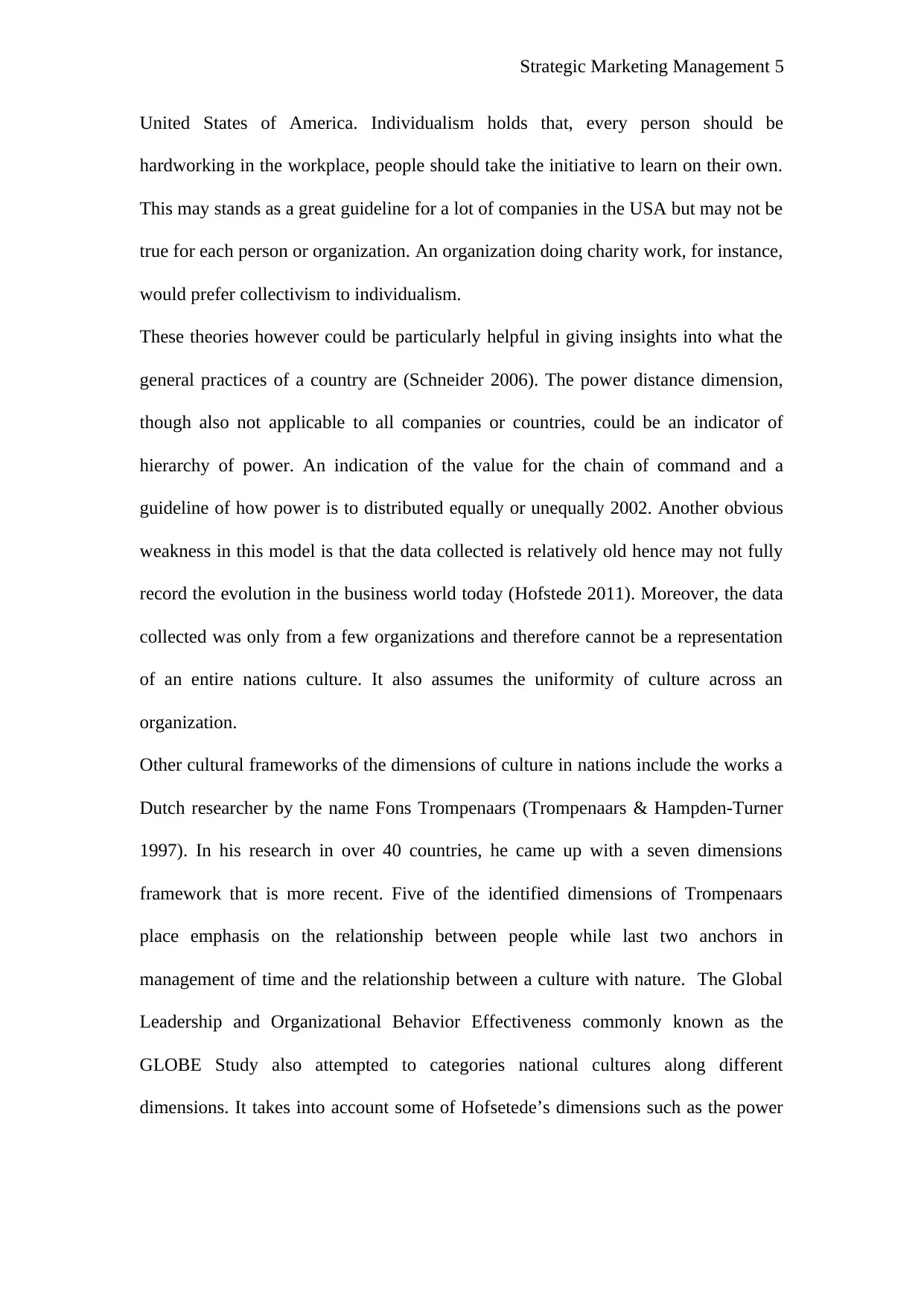
Strategic Marketing Management 5
United States of America. Individualism holds that, every person should be
hardworking in the workplace, people should take the initiative to learn on their own.
This may stands as a great guideline for a lot of companies in the USA but may not be
true for each person or organization. An organization doing charity work, for instance,
would prefer collectivism to individualism.
These theories however could be particularly helpful in giving insights into what the
general practices of a country are (Schneider 2006). The power distance dimension,
though also not applicable to all companies or countries, could be an indicator of
hierarchy of power. An indication of the value for the chain of command and a
guideline of how power is to distributed equally or unequally 2002. Another obvious
weakness in this model is that the data collected is relatively old hence may not fully
record the evolution in the business world today (Hofstede 2011). Moreover, the data
collected was only from a few organizations and therefore cannot be a representation
of an entire nations culture. It also assumes the uniformity of culture across an
organization.
Other cultural frameworks of the dimensions of culture in nations include the works a
Dutch researcher by the name Fons Trompenaars (Trompenaars & Hampden-Turner
1997). In his research in over 40 countries, he came up with a seven dimensions
framework that is more recent. Five of the identified dimensions of Trompenaars
place emphasis on the relationship between people while last two anchors in
management of time and the relationship between a culture with nature. The Global
Leadership and Organizational Behavior Effectiveness commonly known as the
GLOBE Study also attempted to categories national cultures along different
dimensions. It takes into account some of Hofsetede’s dimensions such as the power
United States of America. Individualism holds that, every person should be
hardworking in the workplace, people should take the initiative to learn on their own.
This may stands as a great guideline for a lot of companies in the USA but may not be
true for each person or organization. An organization doing charity work, for instance,
would prefer collectivism to individualism.
These theories however could be particularly helpful in giving insights into what the
general practices of a country are (Schneider 2006). The power distance dimension,
though also not applicable to all companies or countries, could be an indicator of
hierarchy of power. An indication of the value for the chain of command and a
guideline of how power is to distributed equally or unequally 2002. Another obvious
weakness in this model is that the data collected is relatively old hence may not fully
record the evolution in the business world today (Hofstede 2011). Moreover, the data
collected was only from a few organizations and therefore cannot be a representation
of an entire nations culture. It also assumes the uniformity of culture across an
organization.
Other cultural frameworks of the dimensions of culture in nations include the works a
Dutch researcher by the name Fons Trompenaars (Trompenaars & Hampden-Turner
1997). In his research in over 40 countries, he came up with a seven dimensions
framework that is more recent. Five of the identified dimensions of Trompenaars
place emphasis on the relationship between people while last two anchors in
management of time and the relationship between a culture with nature. The Global
Leadership and Organizational Behavior Effectiveness commonly known as the
GLOBE Study also attempted to categories national cultures along different
dimensions. It takes into account some of Hofsetede’s dimensions such as the power
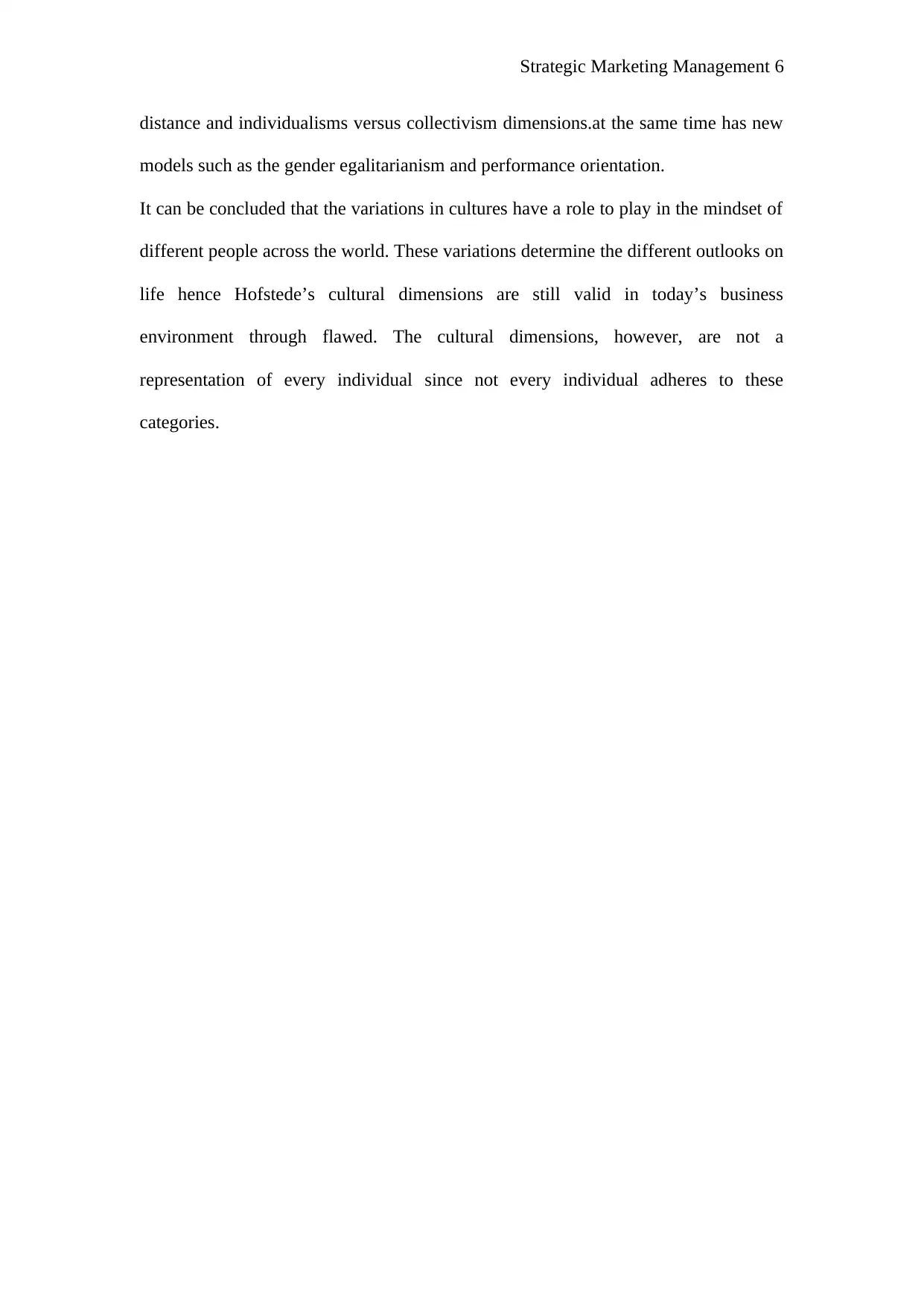
Strategic Marketing Management 6
distance and individualisms versus collectivism dimensions.at the same time has new
models such as the gender egalitarianism and performance orientation.
It can be concluded that the variations in cultures have a role to play in the mindset of
different people across the world. These variations determine the different outlooks on
life hence Hofstede’s cultural dimensions are still valid in today’s business
environment through flawed. The cultural dimensions, however, are not a
representation of every individual since not every individual adheres to these
categories.
distance and individualisms versus collectivism dimensions.at the same time has new
models such as the gender egalitarianism and performance orientation.
It can be concluded that the variations in cultures have a role to play in the mindset of
different people across the world. These variations determine the different outlooks on
life hence Hofstede’s cultural dimensions are still valid in today’s business
environment through flawed. The cultural dimensions, however, are not a
representation of every individual since not every individual adheres to these
categories.
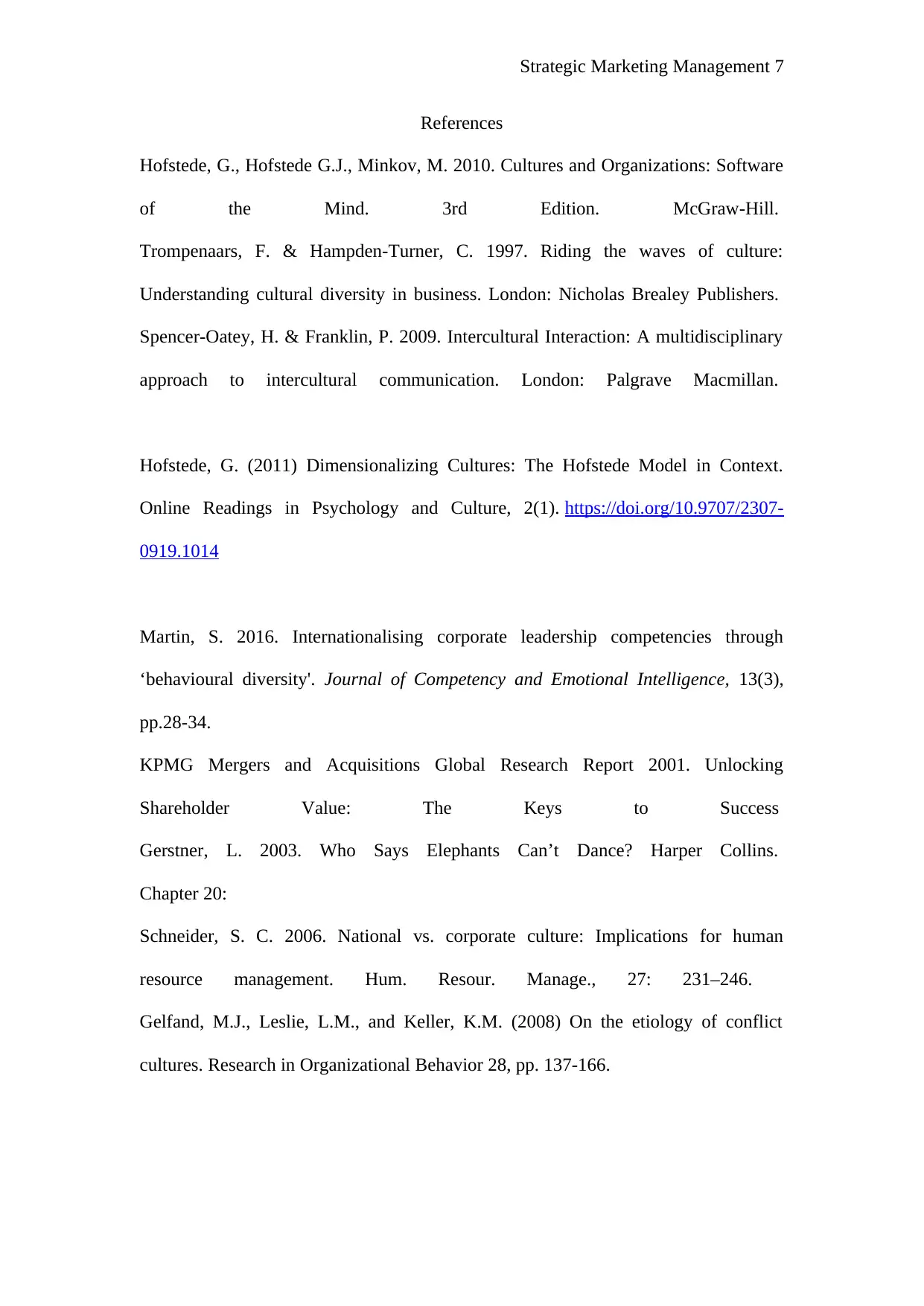
Strategic Marketing Management 7
References
Hofstede, G., Hofstede G.J., Minkov, M. 2010. Cultures and Organizations: Software
of the Mind. 3rd Edition. McGraw-Hill.
Trompenaars, F. & Hampden-Turner, C. 1997. Riding the waves of culture:
Understanding cultural diversity in business. London: Nicholas Brealey Publishers.
Spencer-Oatey, H. & Franklin, P. 2009. Intercultural Interaction: A multidisciplinary
approach to intercultural communication. London: Palgrave Macmillan.
Hofstede, G. (2011) Dimensionalizing Cultures: The Hofstede Model in Context.
Online Readings in Psychology and Culture, 2(1). https://doi.org/10.9707/2307-
0919.1014
Martin, S. 2016. Internationalising corporate leadership competencies through
‘behavioural diversity'. Journal of Competency and Emotional Intelligence, 13(3),
pp.28-34.
KPMG Mergers and Acquisitions Global Research Report 2001. Unlocking
Shareholder Value: The Keys to Success
Gerstner, L. 2003. Who Says Elephants Can’t Dance? Harper Collins.
Chapter 20:
Schneider, S. C. 2006. National vs. corporate culture: Implications for human
resource management. Hum. Resour. Manage., 27: 231–246.
Gelfand, M.J., Leslie, L.M., and Keller, K.M. (2008) On the etiology of conflict
cultures. Research in Organizational Behavior 28, pp. 137-166.
References
Hofstede, G., Hofstede G.J., Minkov, M. 2010. Cultures and Organizations: Software
of the Mind. 3rd Edition. McGraw-Hill.
Trompenaars, F. & Hampden-Turner, C. 1997. Riding the waves of culture:
Understanding cultural diversity in business. London: Nicholas Brealey Publishers.
Spencer-Oatey, H. & Franklin, P. 2009. Intercultural Interaction: A multidisciplinary
approach to intercultural communication. London: Palgrave Macmillan.
Hofstede, G. (2011) Dimensionalizing Cultures: The Hofstede Model in Context.
Online Readings in Psychology and Culture, 2(1). https://doi.org/10.9707/2307-
0919.1014
Martin, S. 2016. Internationalising corporate leadership competencies through
‘behavioural diversity'. Journal of Competency and Emotional Intelligence, 13(3),
pp.28-34.
KPMG Mergers and Acquisitions Global Research Report 2001. Unlocking
Shareholder Value: The Keys to Success
Gerstner, L. 2003. Who Says Elephants Can’t Dance? Harper Collins.
Chapter 20:
Schneider, S. C. 2006. National vs. corporate culture: Implications for human
resource management. Hum. Resour. Manage., 27: 231–246.
Gelfand, M.J., Leslie, L.M., and Keller, K.M. (2008) On the etiology of conflict
cultures. Research in Organizational Behavior 28, pp. 137-166.
Paraphrase This Document
Need a fresh take? Get an instant paraphrase of this document with our AI Paraphraser
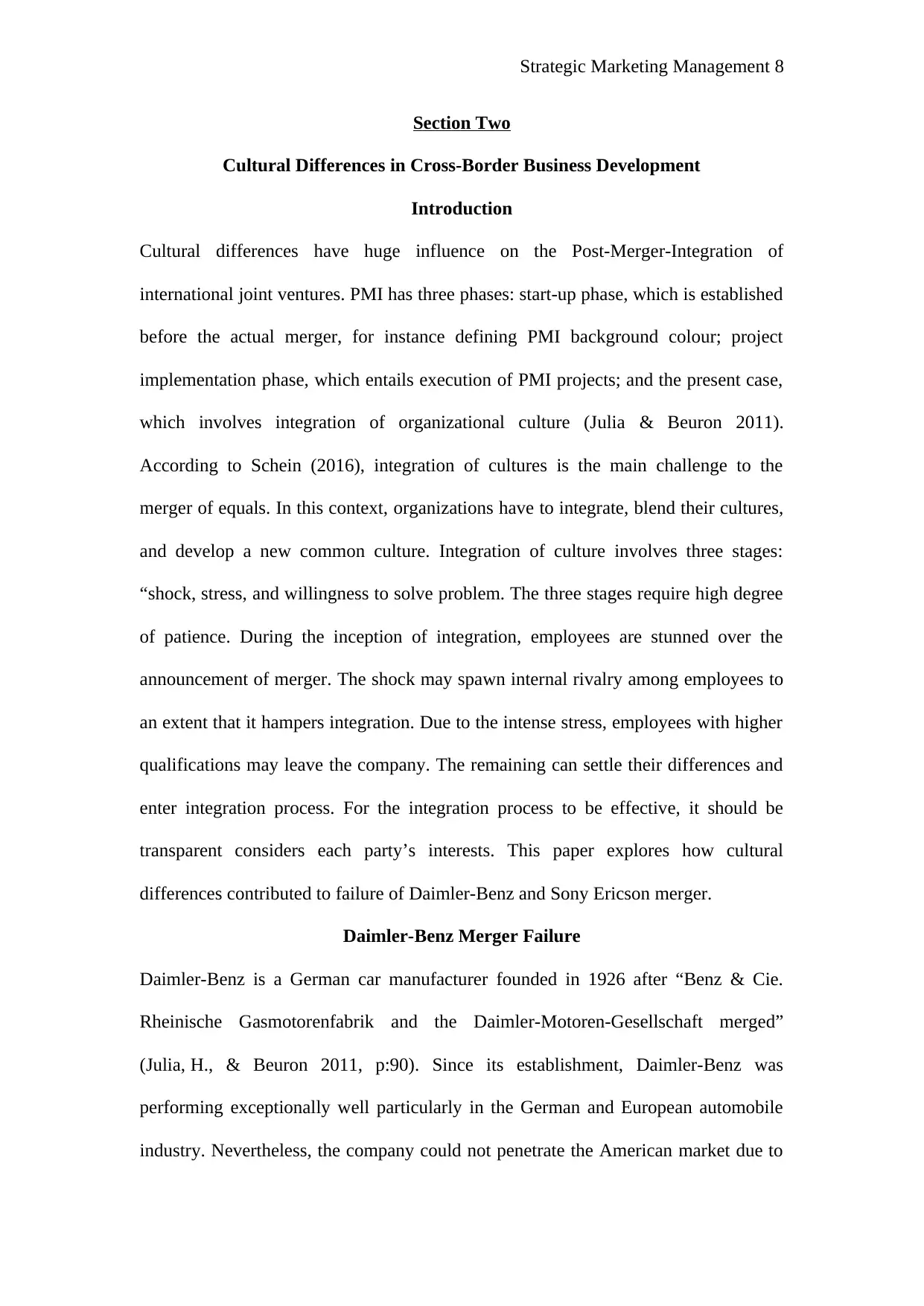
Strategic Marketing Management 8
Section Two
Cultural Differences in Cross-Border Business Development
Introduction
Cultural differences have huge influence on the Post-Merger-Integration of
international joint ventures. PMI has three phases: start-up phase, which is established
before the actual merger, for instance defining PMI background colour; project
implementation phase, which entails execution of PMI projects; and the present case,
which involves integration of organizational culture (Julia & Beuron 2011).
According to Schein (2016), integration of cultures is the main challenge to the
merger of equals. In this context, organizations have to integrate, blend their cultures,
and develop a new common culture. Integration of culture involves three stages:
“shock, stress, and willingness to solve problem. The three stages require high degree
of patience. During the inception of integration, employees are stunned over the
announcement of merger. The shock may spawn internal rivalry among employees to
an extent that it hampers integration. Due to the intense stress, employees with higher
qualifications may leave the company. The remaining can settle their differences and
enter integration process. For the integration process to be effective, it should be
transparent considers each party’s interests. This paper explores how cultural
differences contributed to failure of Daimler-Benz and Sony Ericson merger.
Daimler-Benz Merger Failure
Daimler-Benz is a German car manufacturer founded in 1926 after “Benz & Cie.
Rheinische Gasmotorenfabrik and the Daimler-Motoren-Gesellschaft merged”
(Julia, H., & Beuron 2011, p:90). Since its establishment, Daimler-Benz was
performing exceptionally well particularly in the German and European automobile
industry. Nevertheless, the company could not penetrate the American market due to
Section Two
Cultural Differences in Cross-Border Business Development
Introduction
Cultural differences have huge influence on the Post-Merger-Integration of
international joint ventures. PMI has three phases: start-up phase, which is established
before the actual merger, for instance defining PMI background colour; project
implementation phase, which entails execution of PMI projects; and the present case,
which involves integration of organizational culture (Julia & Beuron 2011).
According to Schein (2016), integration of cultures is the main challenge to the
merger of equals. In this context, organizations have to integrate, blend their cultures,
and develop a new common culture. Integration of culture involves three stages:
“shock, stress, and willingness to solve problem. The three stages require high degree
of patience. During the inception of integration, employees are stunned over the
announcement of merger. The shock may spawn internal rivalry among employees to
an extent that it hampers integration. Due to the intense stress, employees with higher
qualifications may leave the company. The remaining can settle their differences and
enter integration process. For the integration process to be effective, it should be
transparent considers each party’s interests. This paper explores how cultural
differences contributed to failure of Daimler-Benz and Sony Ericson merger.
Daimler-Benz Merger Failure
Daimler-Benz is a German car manufacturer founded in 1926 after “Benz & Cie.
Rheinische Gasmotorenfabrik and the Daimler-Motoren-Gesellschaft merged”
(Julia, H., & Beuron 2011, p:90). Since its establishment, Daimler-Benz was
performing exceptionally well particularly in the German and European automobile
industry. Nevertheless, the company could not penetrate the American market due to
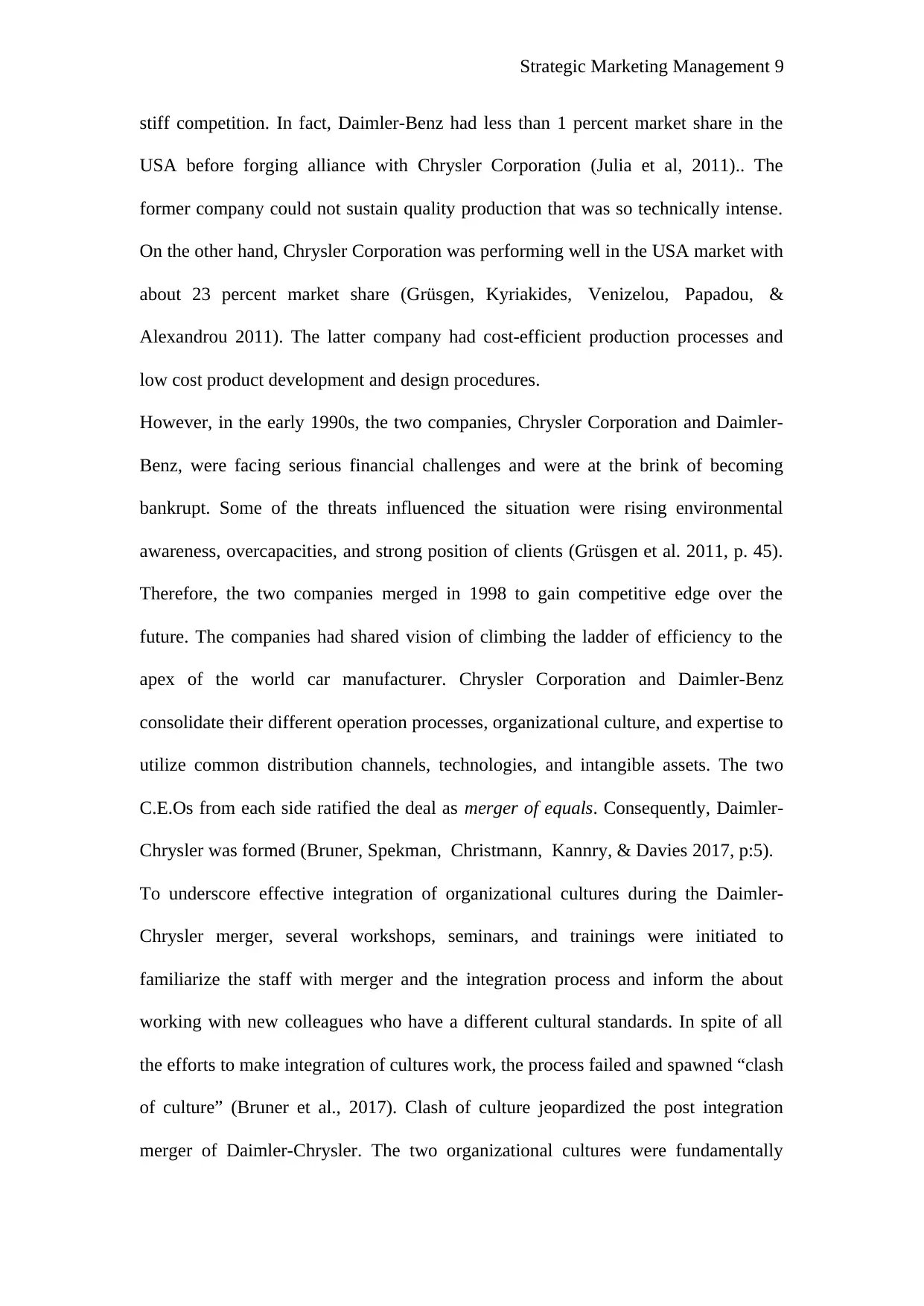
Strategic Marketing Management 9
stiff competition. In fact, Daimler-Benz had less than 1 percent market share in the
USA before forging alliance with Chrysler Corporation (Julia et al, 2011).. The
former company could not sustain quality production that was so technically intense.
On the other hand, Chrysler Corporation was performing well in the USA market with
about 23 percent market share (Grüsgen, Kyriakides, Venizelou, Papadou, &
Alexandrou 2011). The latter company had cost-efficient production processes and
low cost product development and design procedures.
However, in the early 1990s, the two companies, Chrysler Corporation and Daimler-
Benz, were facing serious financial challenges and were at the brink of becoming
bankrupt. Some of the threats influenced the situation were rising environmental
awareness, overcapacities, and strong position of clients (Grüsgen et al. 2011, p. 45).
Therefore, the two companies merged in 1998 to gain competitive edge over the
future. The companies had shared vision of climbing the ladder of efficiency to the
apex of the world car manufacturer. Chrysler Corporation and Daimler-Benz
consolidate their different operation processes, organizational culture, and expertise to
utilize common distribution channels, technologies, and intangible assets. The two
C.E.Os from each side ratified the deal as merger of equals. Consequently, Daimler-
Chrysler was formed (Bruner, Spekman, Christmann, Kannry, & Davies 2017, p:5).
To underscore effective integration of organizational cultures during the Daimler-
Chrysler merger, several workshops, seminars, and trainings were initiated to
familiarize the staff with merger and the integration process and inform the about
working with new colleagues who have a different cultural standards. In spite of all
the efforts to make integration of cultures work, the process failed and spawned “clash
of culture” (Bruner et al., 2017). Clash of culture jeopardized the post integration
merger of Daimler-Chrysler. The two organizational cultures were fundamentally
stiff competition. In fact, Daimler-Benz had less than 1 percent market share in the
USA before forging alliance with Chrysler Corporation (Julia et al, 2011).. The
former company could not sustain quality production that was so technically intense.
On the other hand, Chrysler Corporation was performing well in the USA market with
about 23 percent market share (Grüsgen, Kyriakides, Venizelou, Papadou, &
Alexandrou 2011). The latter company had cost-efficient production processes and
low cost product development and design procedures.
However, in the early 1990s, the two companies, Chrysler Corporation and Daimler-
Benz, were facing serious financial challenges and were at the brink of becoming
bankrupt. Some of the threats influenced the situation were rising environmental
awareness, overcapacities, and strong position of clients (Grüsgen et al. 2011, p. 45).
Therefore, the two companies merged in 1998 to gain competitive edge over the
future. The companies had shared vision of climbing the ladder of efficiency to the
apex of the world car manufacturer. Chrysler Corporation and Daimler-Benz
consolidate their different operation processes, organizational culture, and expertise to
utilize common distribution channels, technologies, and intangible assets. The two
C.E.Os from each side ratified the deal as merger of equals. Consequently, Daimler-
Chrysler was formed (Bruner, Spekman, Christmann, Kannry, & Davies 2017, p:5).
To underscore effective integration of organizational cultures during the Daimler-
Chrysler merger, several workshops, seminars, and trainings were initiated to
familiarize the staff with merger and the integration process and inform the about
working with new colleagues who have a different cultural standards. In spite of all
the efforts to make integration of cultures work, the process failed and spawned “clash
of culture” (Bruner et al., 2017). Clash of culture jeopardized the post integration
merger of Daimler-Chrysler. The two organizational cultures were fundamentally
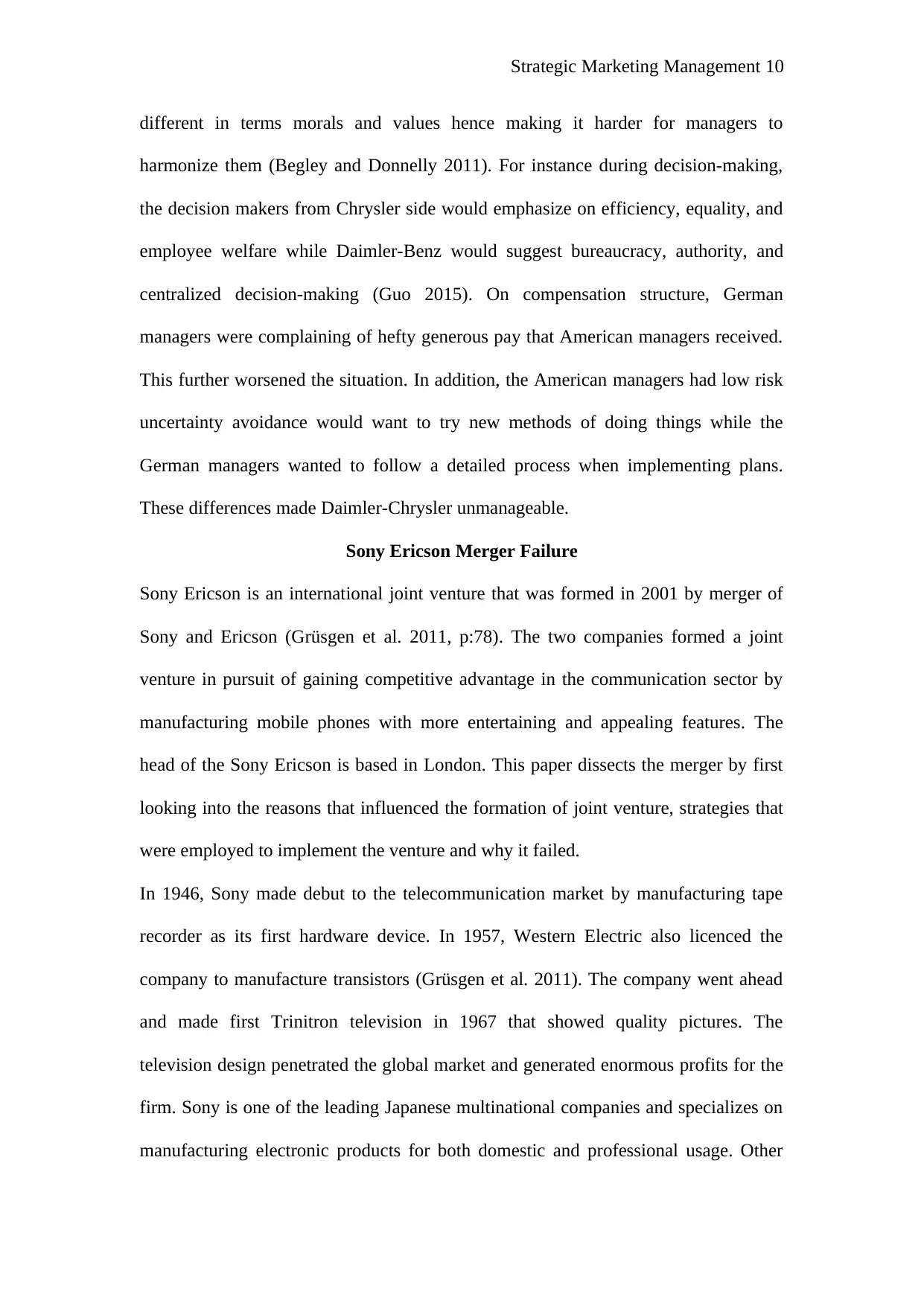
Strategic Marketing Management 10
different in terms morals and values hence making it harder for managers to
harmonize them (Begley and Donnelly 2011). For instance during decision-making,
the decision makers from Chrysler side would emphasize on efficiency, equality, and
employee welfare while Daimler-Benz would suggest bureaucracy, authority, and
centralized decision-making (Guo 2015). On compensation structure, German
managers were complaining of hefty generous pay that American managers received.
This further worsened the situation. In addition, the American managers had low risk
uncertainty avoidance would want to try new methods of doing things while the
German managers wanted to follow a detailed process when implementing plans.
These differences made Daimler-Chrysler unmanageable.
Sony Ericson Merger Failure
Sony Ericson is an international joint venture that was formed in 2001 by merger of
Sony and Ericson (Grüsgen et al. 2011, p:78). The two companies formed a joint
venture in pursuit of gaining competitive advantage in the communication sector by
manufacturing mobile phones with more entertaining and appealing features. The
head of the Sony Ericson is based in London. This paper dissects the merger by first
looking into the reasons that influenced the formation of joint venture, strategies that
were employed to implement the venture and why it failed.
In 1946, Sony made debut to the telecommunication market by manufacturing tape
recorder as its first hardware device. In 1957, Western Electric also licenced the
company to manufacture transistors (Grüsgen et al. 2011). The company went ahead
and made first Trinitron television in 1967 that showed quality pictures. The
television design penetrated the global market and generated enormous profits for the
firm. Sony is one of the leading Japanese multinational companies and specializes on
manufacturing electronic products for both domestic and professional usage. Other
different in terms morals and values hence making it harder for managers to
harmonize them (Begley and Donnelly 2011). For instance during decision-making,
the decision makers from Chrysler side would emphasize on efficiency, equality, and
employee welfare while Daimler-Benz would suggest bureaucracy, authority, and
centralized decision-making (Guo 2015). On compensation structure, German
managers were complaining of hefty generous pay that American managers received.
This further worsened the situation. In addition, the American managers had low risk
uncertainty avoidance would want to try new methods of doing things while the
German managers wanted to follow a detailed process when implementing plans.
These differences made Daimler-Chrysler unmanageable.
Sony Ericson Merger Failure
Sony Ericson is an international joint venture that was formed in 2001 by merger of
Sony and Ericson (Grüsgen et al. 2011, p:78). The two companies formed a joint
venture in pursuit of gaining competitive advantage in the communication sector by
manufacturing mobile phones with more entertaining and appealing features. The
head of the Sony Ericson is based in London. This paper dissects the merger by first
looking into the reasons that influenced the formation of joint venture, strategies that
were employed to implement the venture and why it failed.
In 1946, Sony made debut to the telecommunication market by manufacturing tape
recorder as its first hardware device. In 1957, Western Electric also licenced the
company to manufacture transistors (Grüsgen et al. 2011). The company went ahead
and made first Trinitron television in 1967 that showed quality pictures. The
television design penetrated the global market and generated enormous profits for the
firm. Sony is one of the leading Japanese multinational companies and specializes on
manufacturing electronic products for both domestic and professional usage. Other
Secure Best Marks with AI Grader
Need help grading? Try our AI Grader for instant feedback on your assignments.
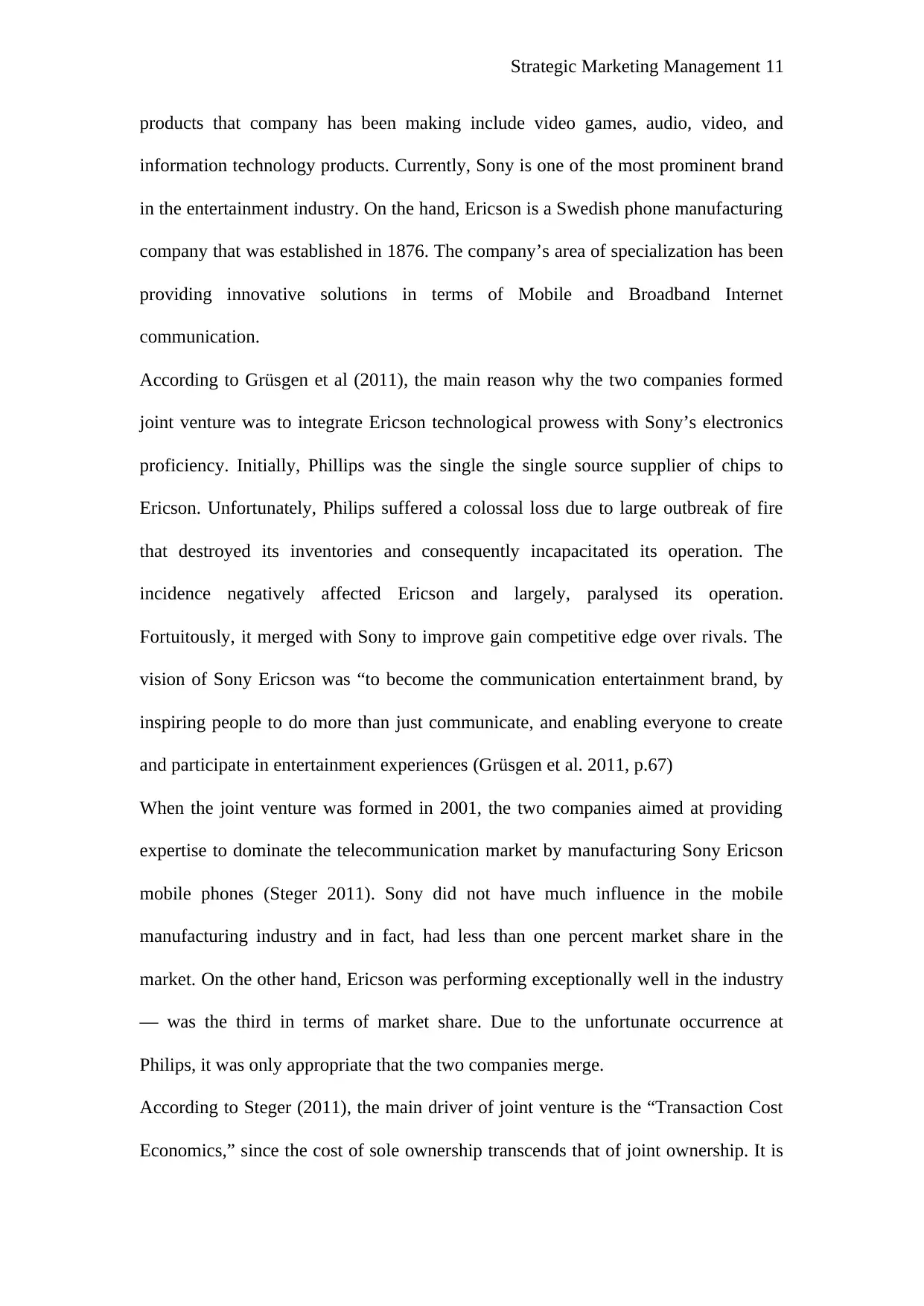
Strategic Marketing Management 11
products that company has been making include video games, audio, video, and
information technology products. Currently, Sony is one of the most prominent brand
in the entertainment industry. On the hand, Ericson is a Swedish phone manufacturing
company that was established in 1876. The company’s area of specialization has been
providing innovative solutions in terms of Mobile and Broadband Internet
communication.
According to Grüsgen et al (2011), the main reason why the two companies formed
joint venture was to integrate Ericson technological prowess with Sony’s electronics
proficiency. Initially, Phillips was the single the single source supplier of chips to
Ericson. Unfortunately, Philips suffered a colossal loss due to large outbreak of fire
that destroyed its inventories and consequently incapacitated its operation. The
incidence negatively affected Ericson and largely, paralysed its operation.
Fortuitously, it merged with Sony to improve gain competitive edge over rivals. The
vision of Sony Ericson was “to become the communication entertainment brand, by
inspiring people to do more than just communicate, and enabling everyone to create
and participate in entertainment experiences (Grüsgen et al. 2011, p.67)
When the joint venture was formed in 2001, the two companies aimed at providing
expertise to dominate the telecommunication market by manufacturing Sony Ericson
mobile phones (Steger 2011). Sony did not have much influence in the mobile
manufacturing industry and in fact, had less than one percent market share in the
market. On the other hand, Ericson was performing exceptionally well in the industry
— was the third in terms of market share. Due to the unfortunate occurrence at
Philips, it was only appropriate that the two companies merge.
According to Steger (2011), the main driver of joint venture is the “Transaction Cost
Economics,” since the cost of sole ownership transcends that of joint ownership. It is
products that company has been making include video games, audio, video, and
information technology products. Currently, Sony is one of the most prominent brand
in the entertainment industry. On the hand, Ericson is a Swedish phone manufacturing
company that was established in 1876. The company’s area of specialization has been
providing innovative solutions in terms of Mobile and Broadband Internet
communication.
According to Grüsgen et al (2011), the main reason why the two companies formed
joint venture was to integrate Ericson technological prowess with Sony’s electronics
proficiency. Initially, Phillips was the single the single source supplier of chips to
Ericson. Unfortunately, Philips suffered a colossal loss due to large outbreak of fire
that destroyed its inventories and consequently incapacitated its operation. The
incidence negatively affected Ericson and largely, paralysed its operation.
Fortuitously, it merged with Sony to improve gain competitive edge over rivals. The
vision of Sony Ericson was “to become the communication entertainment brand, by
inspiring people to do more than just communicate, and enabling everyone to create
and participate in entertainment experiences (Grüsgen et al. 2011, p.67)
When the joint venture was formed in 2001, the two companies aimed at providing
expertise to dominate the telecommunication market by manufacturing Sony Ericson
mobile phones (Steger 2011). Sony did not have much influence in the mobile
manufacturing industry and in fact, had less than one percent market share in the
market. On the other hand, Ericson was performing exceptionally well in the industry
— was the third in terms of market share. Due to the unfortunate occurrence at
Philips, it was only appropriate that the two companies merge.
According to Steger (2011), the main driver of joint venture is the “Transaction Cost
Economics,” since the cost of sole ownership transcends that of joint ownership. It is

Strategic Marketing Management 12
for this reason that Sony found it propitious to sign the deal with Ericson, to gain
competitive edge in the mobile industry while Ericson needed to save itself from
collapsing. Another factor that influenced Sony was the fact that it was going to
benefit from the Ericson’s vital intangible resources, which would enable the
company to improve its performance in the mobile phone manufacturing industry
(Abesi 2016. P: 6). The organizational learning and strategic management also
motivated the two companies since they wanted to utilize each one’s unique skills.
After formation of the alliance, the two companies ceased manufacturing their
separate cell phones and began working together. Sony Ericson designed a strategy to
make new models that had had digital cameras and could be able to download videos.
The main innovation was cheap camera mobile phones and cross platform operating
system.
However, the joint venture could not conjure up profits as expected. Sony Ericson
made losses due to misrepresentation of the product in the market, an aspect that was
believed to have occurred due to cultural differences that has direct effect on choice.
According to Grüsgen et al (2011), the products did not essentially meet the
consumer’s expectations. The author attributes this failure to deficient research and
development techniques towards different cultural aspects that affects the
performance of the organzation. In addition, the companies were unable to establish
the reason for the loss. The joint venture failed due to their failure to develop strong
customer base products. Consequently, customers switched to their competitive
products. While they were developing innovative products, marketing strategy was
not effectual; hence, they could not attract buyers. Joint venture can be successful if
the organization has a clear vision to guide its operations (Grüsgen et al. 2011, p. 89).
Sony Ericson could not meet the target profits and kept making losses. In addition,
for this reason that Sony found it propitious to sign the deal with Ericson, to gain
competitive edge in the mobile industry while Ericson needed to save itself from
collapsing. Another factor that influenced Sony was the fact that it was going to
benefit from the Ericson’s vital intangible resources, which would enable the
company to improve its performance in the mobile phone manufacturing industry
(Abesi 2016. P: 6). The organizational learning and strategic management also
motivated the two companies since they wanted to utilize each one’s unique skills.
After formation of the alliance, the two companies ceased manufacturing their
separate cell phones and began working together. Sony Ericson designed a strategy to
make new models that had had digital cameras and could be able to download videos.
The main innovation was cheap camera mobile phones and cross platform operating
system.
However, the joint venture could not conjure up profits as expected. Sony Ericson
made losses due to misrepresentation of the product in the market, an aspect that was
believed to have occurred due to cultural differences that has direct effect on choice.
According to Grüsgen et al (2011), the products did not essentially meet the
consumer’s expectations. The author attributes this failure to deficient research and
development techniques towards different cultural aspects that affects the
performance of the organzation. In addition, the companies were unable to establish
the reason for the loss. The joint venture failed due to their failure to develop strong
customer base products. Consequently, customers switched to their competitive
products. While they were developing innovative products, marketing strategy was
not effectual; hence, they could not attract buyers. Joint venture can be successful if
the organization has a clear vision to guide its operations (Grüsgen et al. 2011, p. 89).
Sony Ericson could not meet the target profits and kept making losses. In addition,
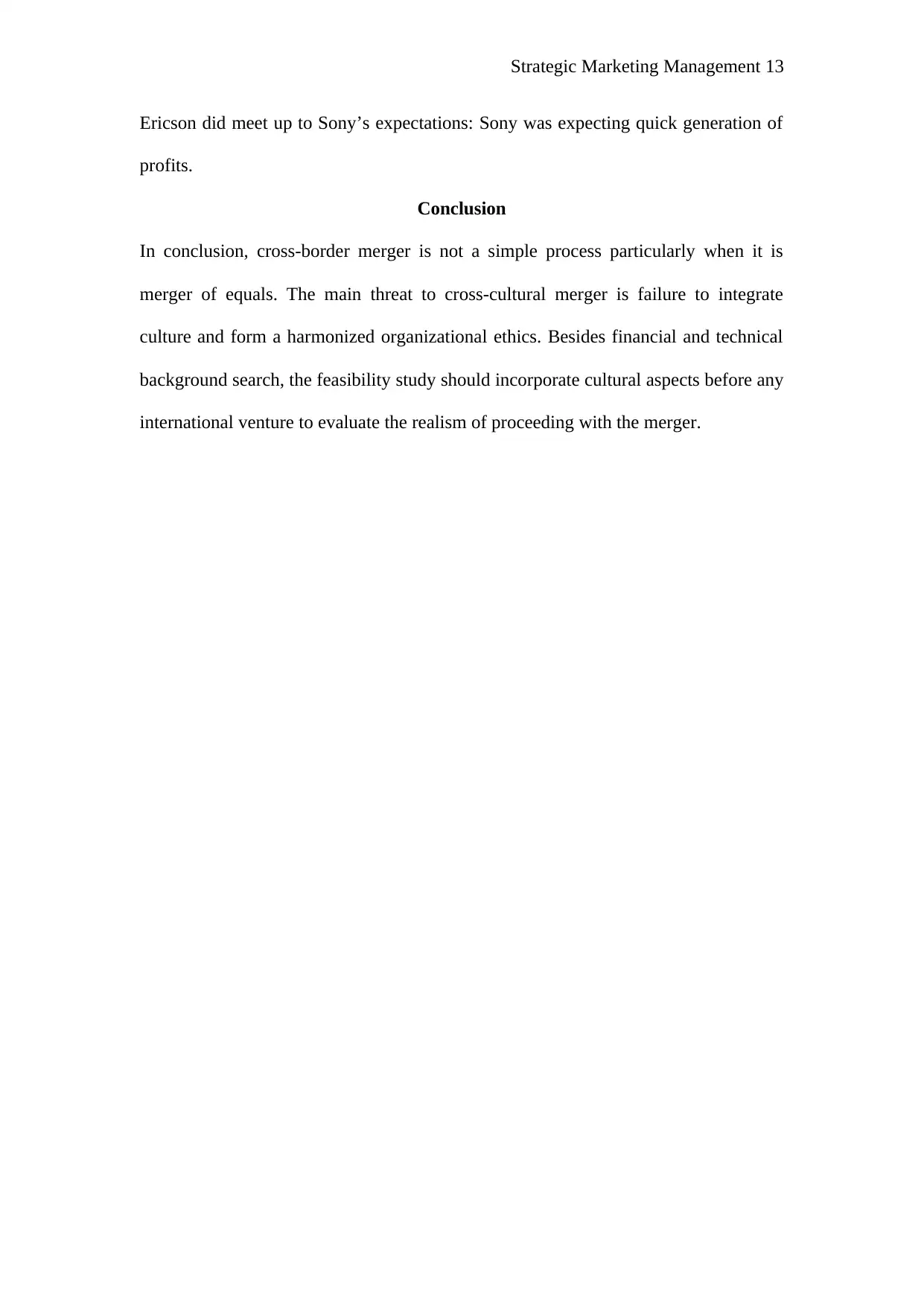
Strategic Marketing Management 13
Ericson did meet up to Sony’s expectations: Sony was expecting quick generation of
profits.
Conclusion
In conclusion, cross-border merger is not a simple process particularly when it is
merger of equals. The main threat to cross-cultural merger is failure to integrate
culture and form a harmonized organizational ethics. Besides financial and technical
background search, the feasibility study should incorporate cultural aspects before any
international venture to evaluate the realism of proceeding with the merger.
Ericson did meet up to Sony’s expectations: Sony was expecting quick generation of
profits.
Conclusion
In conclusion, cross-border merger is not a simple process particularly when it is
merger of equals. The main threat to cross-cultural merger is failure to integrate
culture and form a harmonized organizational ethics. Besides financial and technical
background search, the feasibility study should incorporate cultural aspects before any
international venture to evaluate the realism of proceeding with the merger.
Paraphrase This Document
Need a fresh take? Get an instant paraphrase of this document with our AI Paraphraser
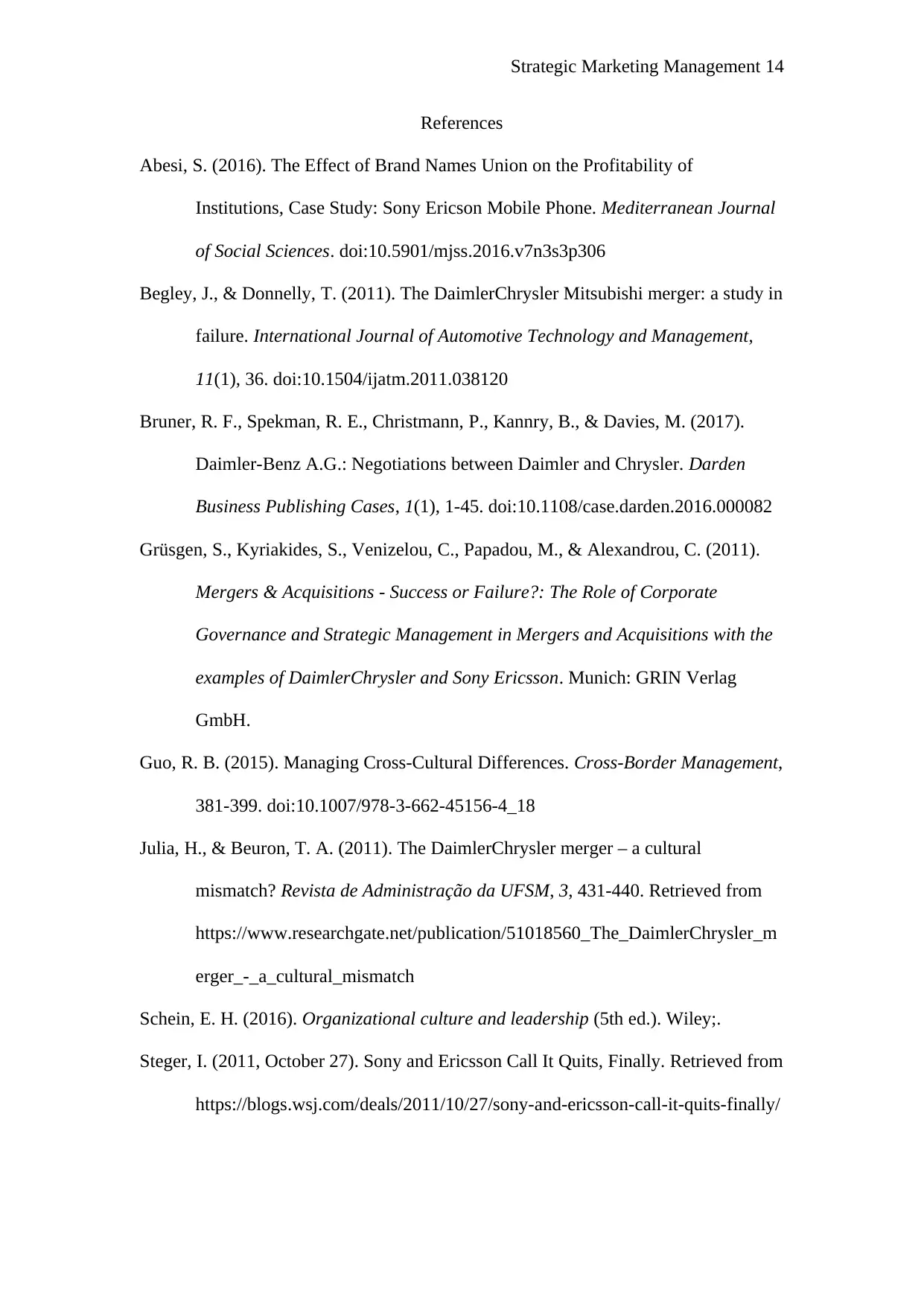
Strategic Marketing Management 14
References
Abesi, S. (2016). The Effect of Brand Names Union on the Profitability of
Institutions, Case Study: Sony Ericson Mobile Phone. Mediterranean Journal
of Social Sciences. doi:10.5901/mjss.2016.v7n3s3p306
Begley, J., & Donnelly, T. (2011). The DaimlerChrysler Mitsubishi merger: a study in
failure. International Journal of Automotive Technology and Management,
11(1), 36. doi:10.1504/ijatm.2011.038120
Bruner, R. F., Spekman, R. E., Christmann, P., Kannry, B., & Davies, M. (2017).
Daimler-Benz A.G.: Negotiations between Daimler and Chrysler. Darden
Business Publishing Cases, 1(1), 1-45. doi:10.1108/case.darden.2016.000082
Grüsgen, S., Kyriakides, S., Venizelou, C., Papadou, M., & Alexandrou, C. (2011).
Mergers & Acquisitions - Success or Failure?: The Role of Corporate
Governance and Strategic Management in Mergers and Acquisitions with the
examples of DaimlerChrysler and Sony Ericsson. Munich: GRIN Verlag
GmbH.
Guo, R. B. (2015). Managing Cross-Cultural Differences. Cross-Border Management,
381-399. doi:10.1007/978-3-662-45156-4_18
Julia, H., & Beuron, T. A. (2011). The DaimlerChrysler merger – a cultural
mismatch? Revista de Administração da UFSM, 3, 431-440. Retrieved from
https://www.researchgate.net/publication/51018560_The_DaimlerChrysler_m
erger_-_a_cultural_mismatch
Schein, E. H. (2016). Organizational culture and leadership (5th ed.). Wiley;.
Steger, I. (2011, October 27). Sony and Ericsson Call It Quits, Finally. Retrieved from
https://blogs.wsj.com/deals/2011/10/27/sony-and-ericsson-call-it-quits-finally/
References
Abesi, S. (2016). The Effect of Brand Names Union on the Profitability of
Institutions, Case Study: Sony Ericson Mobile Phone. Mediterranean Journal
of Social Sciences. doi:10.5901/mjss.2016.v7n3s3p306
Begley, J., & Donnelly, T. (2011). The DaimlerChrysler Mitsubishi merger: a study in
failure. International Journal of Automotive Technology and Management,
11(1), 36. doi:10.1504/ijatm.2011.038120
Bruner, R. F., Spekman, R. E., Christmann, P., Kannry, B., & Davies, M. (2017).
Daimler-Benz A.G.: Negotiations between Daimler and Chrysler. Darden
Business Publishing Cases, 1(1), 1-45. doi:10.1108/case.darden.2016.000082
Grüsgen, S., Kyriakides, S., Venizelou, C., Papadou, M., & Alexandrou, C. (2011).
Mergers & Acquisitions - Success or Failure?: The Role of Corporate
Governance and Strategic Management in Mergers and Acquisitions with the
examples of DaimlerChrysler and Sony Ericsson. Munich: GRIN Verlag
GmbH.
Guo, R. B. (2015). Managing Cross-Cultural Differences. Cross-Border Management,
381-399. doi:10.1007/978-3-662-45156-4_18
Julia, H., & Beuron, T. A. (2011). The DaimlerChrysler merger – a cultural
mismatch? Revista de Administração da UFSM, 3, 431-440. Retrieved from
https://www.researchgate.net/publication/51018560_The_DaimlerChrysler_m
erger_-_a_cultural_mismatch
Schein, E. H. (2016). Organizational culture and leadership (5th ed.). Wiley;.
Steger, I. (2011, October 27). Sony and Ericsson Call It Quits, Finally. Retrieved from
https://blogs.wsj.com/deals/2011/10/27/sony-and-ericsson-call-it-quits-finally/
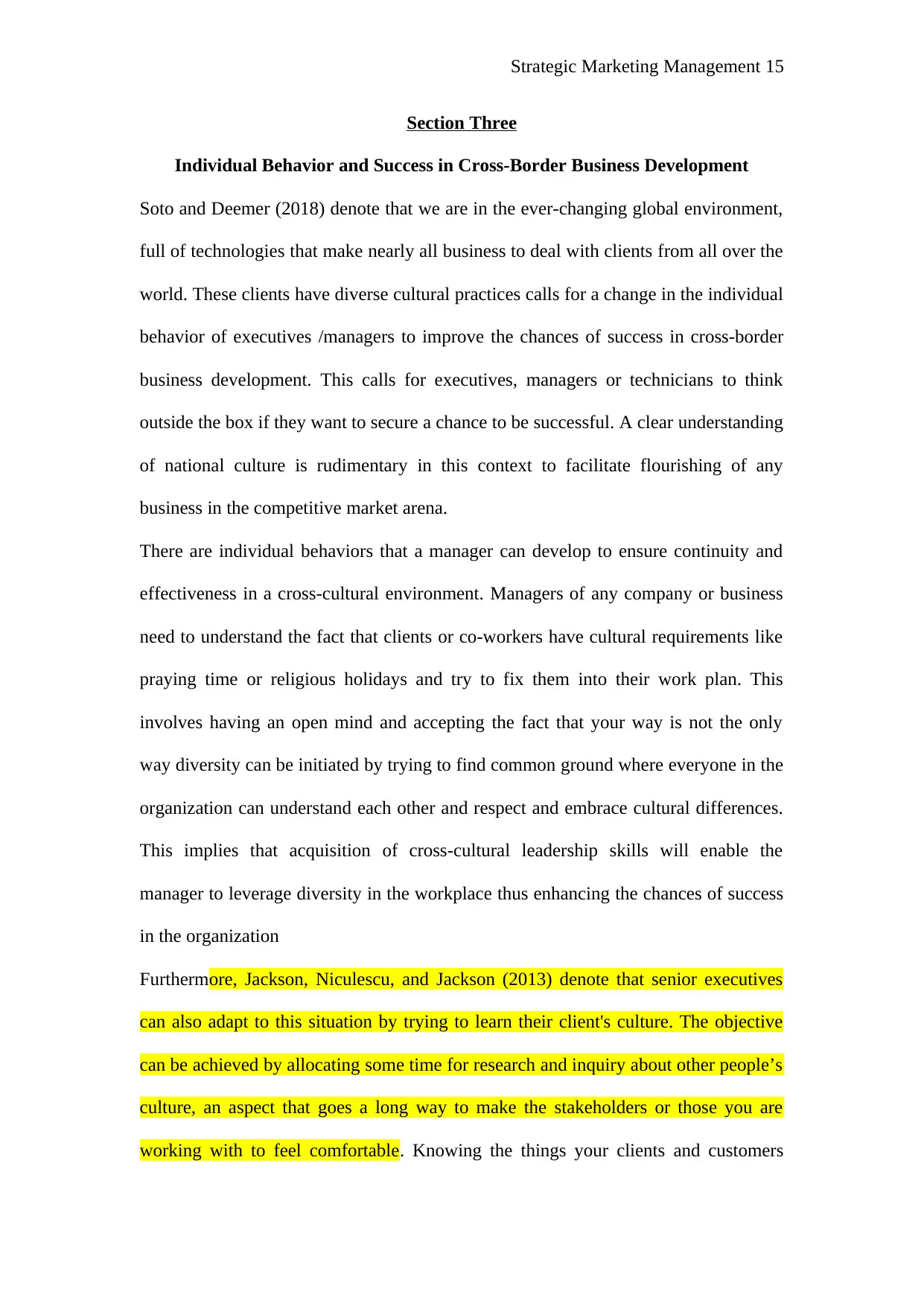
Strategic Marketing Management 15
Section Three
Individual Behavior and Success in Cross-Border Business Development
Soto and Deemer (2018) denote that we are in the ever-changing global environment,
full of technologies that make nearly all business to deal with clients from all over the
world. These clients have diverse cultural practices calls for a change in the individual
behavior of executives /managers to improve the chances of success in cross-border
business development. This calls for executives, managers or technicians to think
outside the box if they want to secure a chance to be successful. A clear understanding
of national culture is rudimentary in this context to facilitate flourishing of any
business in the competitive market arena.
There are individual behaviors that a manager can develop to ensure continuity and
effectiveness in a cross-cultural environment. Managers of any company or business
need to understand the fact that clients or co-workers have cultural requirements like
praying time or religious holidays and try to fix them into their work plan. This
involves having an open mind and accepting the fact that your way is not the only
way diversity can be initiated by trying to find common ground where everyone in the
organization can understand each other and respect and embrace cultural differences.
This implies that acquisition of cross-cultural leadership skills will enable the
manager to leverage diversity in the workplace thus enhancing the chances of success
in the organization
Furthermore, Jackson, Niculescu, and Jackson (2013) denote that senior executives
can also adapt to this situation by trying to learn their client's culture. The objective
can be achieved by allocating some time for research and inquiry about other people’s
culture, an aspect that goes a long way to make the stakeholders or those you are
working with to feel comfortable. Knowing the things your clients and customers
Section Three
Individual Behavior and Success in Cross-Border Business Development
Soto and Deemer (2018) denote that we are in the ever-changing global environment,
full of technologies that make nearly all business to deal with clients from all over the
world. These clients have diverse cultural practices calls for a change in the individual
behavior of executives /managers to improve the chances of success in cross-border
business development. This calls for executives, managers or technicians to think
outside the box if they want to secure a chance to be successful. A clear understanding
of national culture is rudimentary in this context to facilitate flourishing of any
business in the competitive market arena.
There are individual behaviors that a manager can develop to ensure continuity and
effectiveness in a cross-cultural environment. Managers of any company or business
need to understand the fact that clients or co-workers have cultural requirements like
praying time or religious holidays and try to fix them into their work plan. This
involves having an open mind and accepting the fact that your way is not the only
way diversity can be initiated by trying to find common ground where everyone in the
organization can understand each other and respect and embrace cultural differences.
This implies that acquisition of cross-cultural leadership skills will enable the
manager to leverage diversity in the workplace thus enhancing the chances of success
in the organization
Furthermore, Jackson, Niculescu, and Jackson (2013) denote that senior executives
can also adapt to this situation by trying to learn their client's culture. The objective
can be achieved by allocating some time for research and inquiry about other people’s
culture, an aspect that goes a long way to make the stakeholders or those you are
working with to feel comfortable. Knowing the things your clients and customers
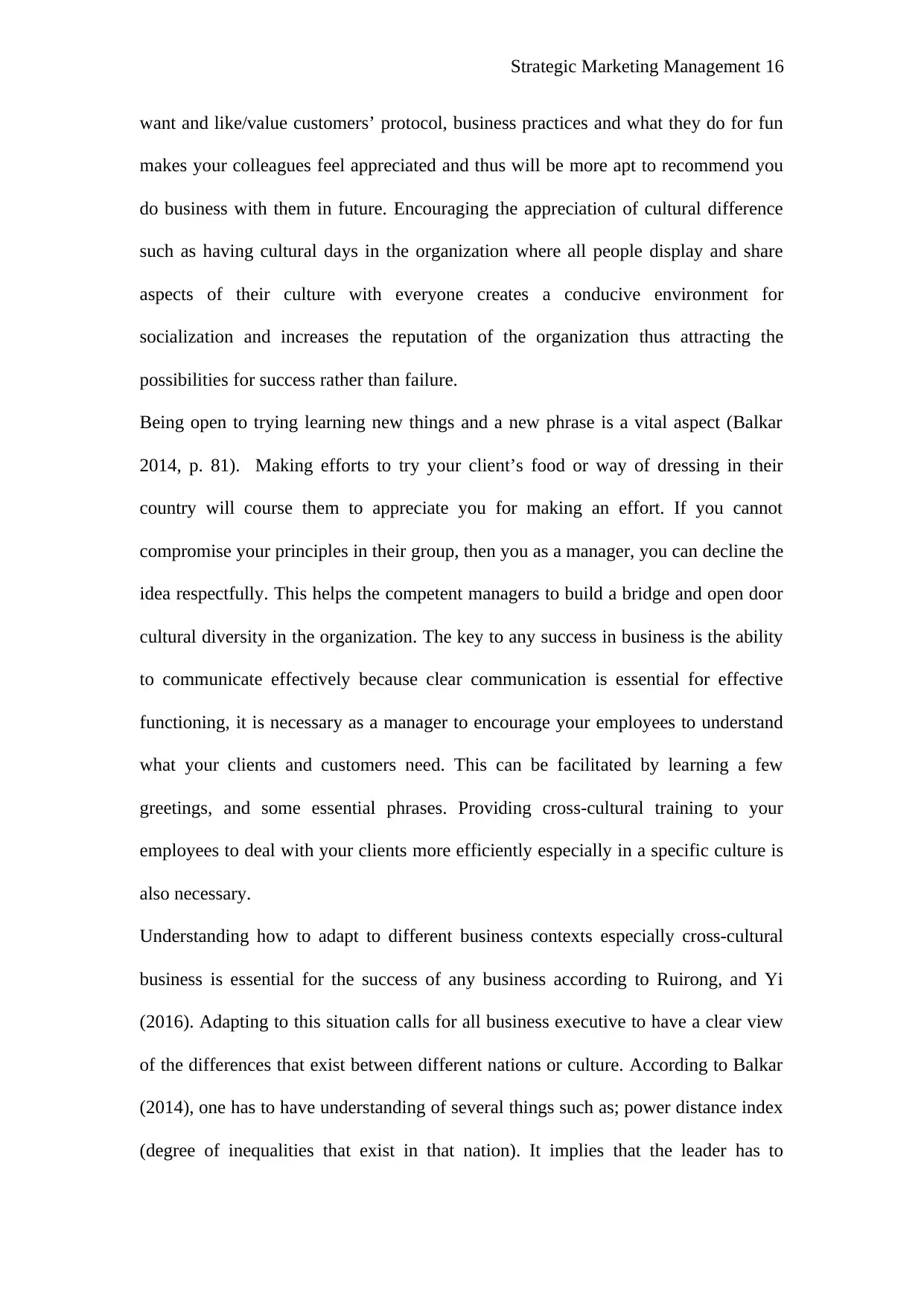
Strategic Marketing Management 16
want and like/value customers’ protocol, business practices and what they do for fun
makes your colleagues feel appreciated and thus will be more apt to recommend you
do business with them in future. Encouraging the appreciation of cultural difference
such as having cultural days in the organization where all people display and share
aspects of their culture with everyone creates a conducive environment for
socialization and increases the reputation of the organization thus attracting the
possibilities for success rather than failure.
Being open to trying learning new things and a new phrase is a vital aspect (Balkar
2014, p. 81). Making efforts to try your client’s food or way of dressing in their
country will course them to appreciate you for making an effort. If you cannot
compromise your principles in their group, then you as a manager, you can decline the
idea respectfully. This helps the competent managers to build a bridge and open door
cultural diversity in the organization. The key to any success in business is the ability
to communicate effectively because clear communication is essential for effective
functioning, it is necessary as a manager to encourage your employees to understand
what your clients and customers need. This can be facilitated by learning a few
greetings, and some essential phrases. Providing cross-cultural training to your
employees to deal with your clients more efficiently especially in a specific culture is
also necessary.
Understanding how to adapt to different business contexts especially cross-cultural
business is essential for the success of any business according to Ruirong, and Yi
(2016). Adapting to this situation calls for all business executive to have a clear view
of the differences that exist between different nations or culture. According to Balkar
(2014), one has to have understanding of several things such as; power distance index
(degree of inequalities that exist in that nation). It implies that the leader has to
want and like/value customers’ protocol, business practices and what they do for fun
makes your colleagues feel appreciated and thus will be more apt to recommend you
do business with them in future. Encouraging the appreciation of cultural difference
such as having cultural days in the organization where all people display and share
aspects of their culture with everyone creates a conducive environment for
socialization and increases the reputation of the organization thus attracting the
possibilities for success rather than failure.
Being open to trying learning new things and a new phrase is a vital aspect (Balkar
2014, p. 81). Making efforts to try your client’s food or way of dressing in their
country will course them to appreciate you for making an effort. If you cannot
compromise your principles in their group, then you as a manager, you can decline the
idea respectfully. This helps the competent managers to build a bridge and open door
cultural diversity in the organization. The key to any success in business is the ability
to communicate effectively because clear communication is essential for effective
functioning, it is necessary as a manager to encourage your employees to understand
what your clients and customers need. This can be facilitated by learning a few
greetings, and some essential phrases. Providing cross-cultural training to your
employees to deal with your clients more efficiently especially in a specific culture is
also necessary.
Understanding how to adapt to different business contexts especially cross-cultural
business is essential for the success of any business according to Ruirong, and Yi
(2016). Adapting to this situation calls for all business executive to have a clear view
of the differences that exist between different nations or culture. According to Balkar
(2014), one has to have understanding of several things such as; power distance index
(degree of inequalities that exist in that nation). It implies that the leader has to
Secure Best Marks with AI Grader
Need help grading? Try our AI Grader for instant feedback on your assignments.
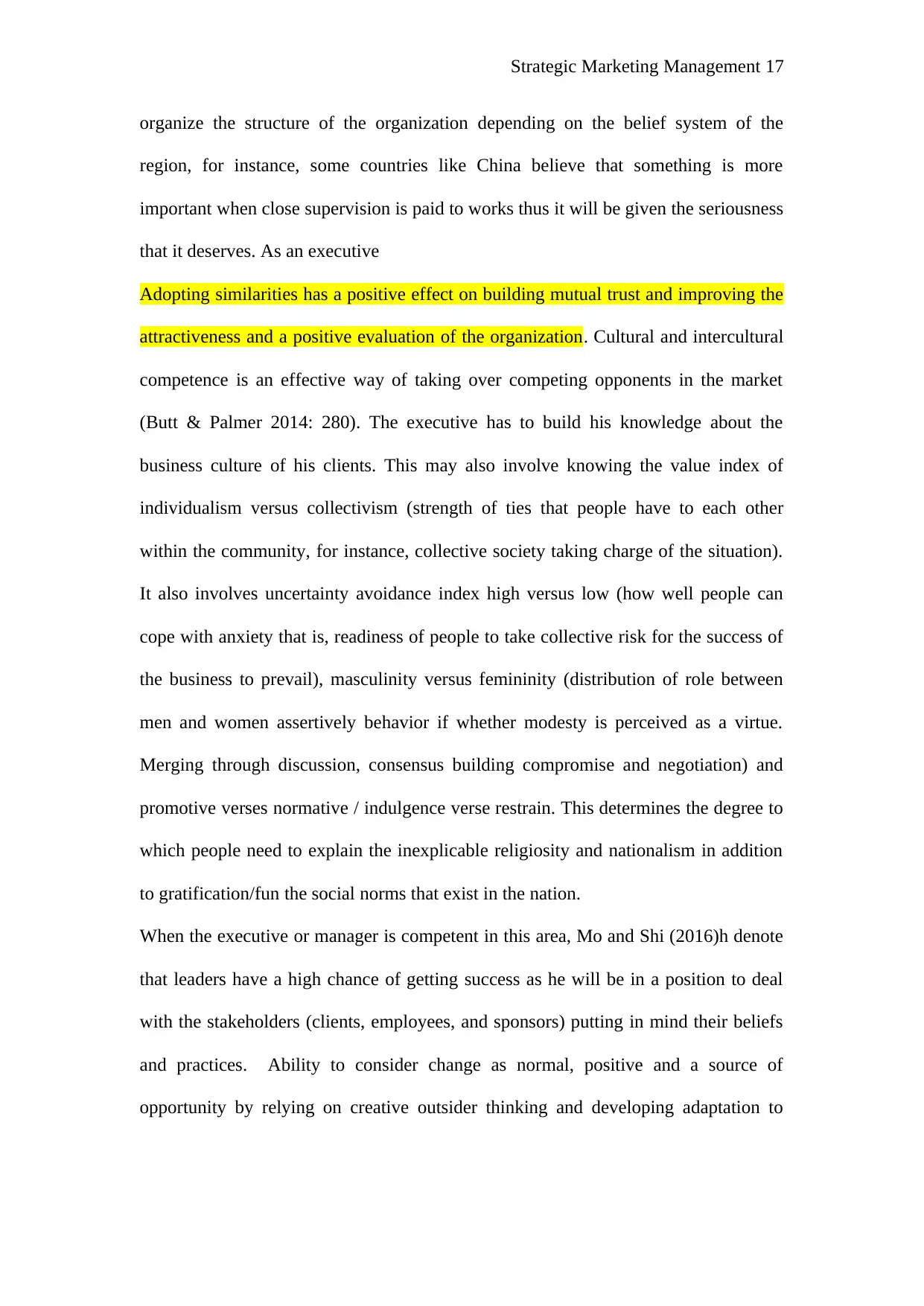
Strategic Marketing Management 17
organize the structure of the organization depending on the belief system of the
region, for instance, some countries like China believe that something is more
important when close supervision is paid to works thus it will be given the seriousness
that it deserves. As an executive
Adopting similarities has a positive effect on building mutual trust and improving the
attractiveness and a positive evaluation of the organization. Cultural and intercultural
competence is an effective way of taking over competing opponents in the market
(Butt & Palmer 2014: 280). The executive has to build his knowledge about the
business culture of his clients. This may also involve knowing the value index of
individualism versus collectivism (strength of ties that people have to each other
within the community, for instance, collective society taking charge of the situation).
It also involves uncertainty avoidance index high versus low (how well people can
cope with anxiety that is, readiness of people to take collective risk for the success of
the business to prevail), masculinity versus femininity (distribution of role between
men and women assertively behavior if whether modesty is perceived as a virtue.
Merging through discussion, consensus building compromise and negotiation) and
promotive verses normative / indulgence verse restrain. This determines the degree to
which people need to explain the inexplicable religiosity and nationalism in addition
to gratification/fun the social norms that exist in the nation.
When the executive or manager is competent in this area, Mo and Shi (2016)h denote
that leaders have a high chance of getting success as he will be in a position to deal
with the stakeholders (clients, employees, and sponsors) putting in mind their beliefs
and practices. Ability to consider change as normal, positive and a source of
opportunity by relying on creative outsider thinking and developing adaptation to
organize the structure of the organization depending on the belief system of the
region, for instance, some countries like China believe that something is more
important when close supervision is paid to works thus it will be given the seriousness
that it deserves. As an executive
Adopting similarities has a positive effect on building mutual trust and improving the
attractiveness and a positive evaluation of the organization. Cultural and intercultural
competence is an effective way of taking over competing opponents in the market
(Butt & Palmer 2014: 280). The executive has to build his knowledge about the
business culture of his clients. This may also involve knowing the value index of
individualism versus collectivism (strength of ties that people have to each other
within the community, for instance, collective society taking charge of the situation).
It also involves uncertainty avoidance index high versus low (how well people can
cope with anxiety that is, readiness of people to take collective risk for the success of
the business to prevail), masculinity versus femininity (distribution of role between
men and women assertively behavior if whether modesty is perceived as a virtue.
Merging through discussion, consensus building compromise and negotiation) and
promotive verses normative / indulgence verse restrain. This determines the degree to
which people need to explain the inexplicable religiosity and nationalism in addition
to gratification/fun the social norms that exist in the nation.
When the executive or manager is competent in this area, Mo and Shi (2016)h denote
that leaders have a high chance of getting success as he will be in a position to deal
with the stakeholders (clients, employees, and sponsors) putting in mind their beliefs
and practices. Ability to consider change as normal, positive and a source of
opportunity by relying on creative outsider thinking and developing adaptation to
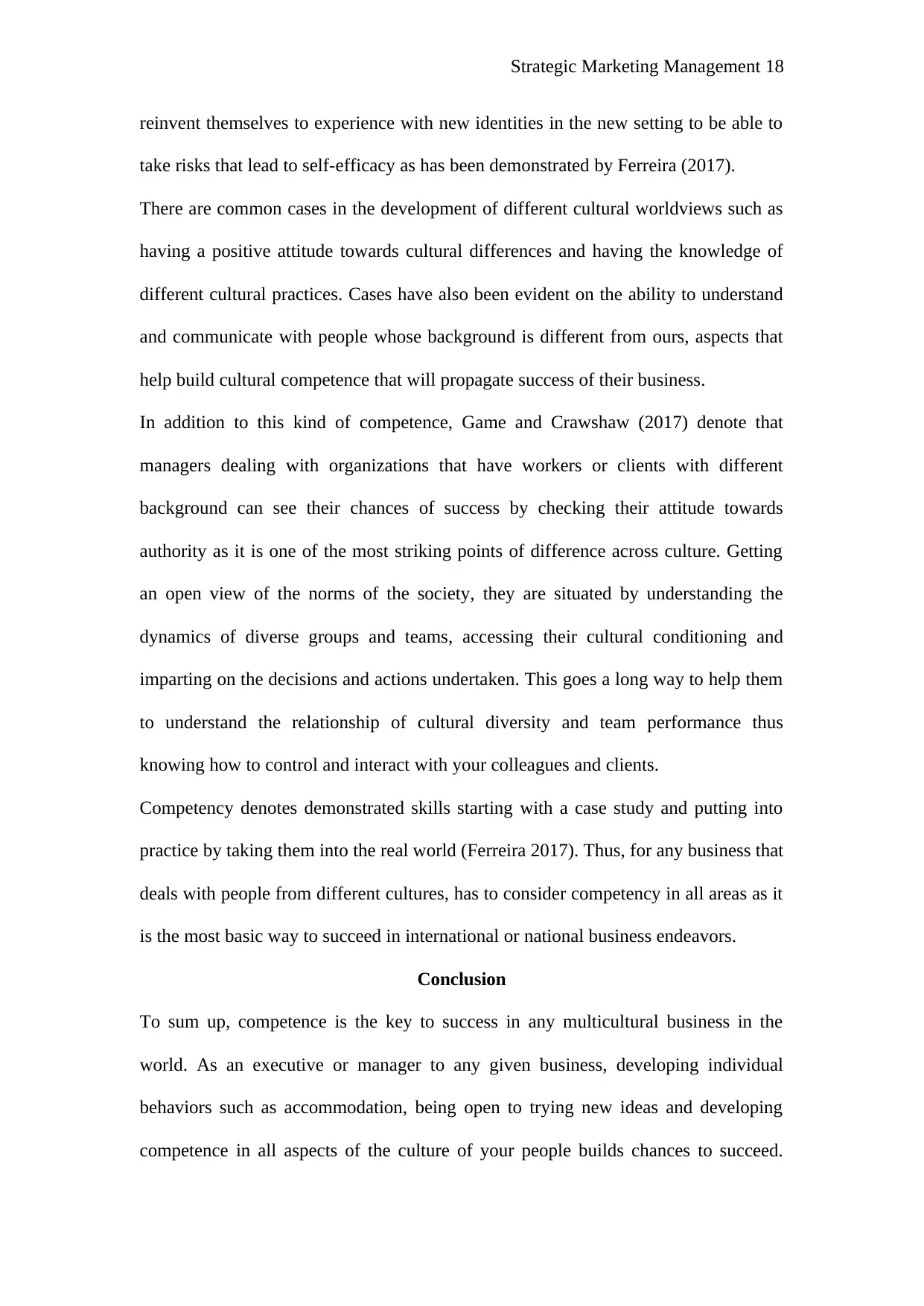
Strategic Marketing Management 18
reinvent themselves to experience with new identities in the new setting to be able to
take risks that lead to self-efficacy as has been demonstrated by Ferreira (2017).
There are common cases in the development of different cultural worldviews such as
having a positive attitude towards cultural differences and having the knowledge of
different cultural practices. Cases have also been evident on the ability to understand
and communicate with people whose background is different from ours, aspects that
help build cultural competence that will propagate success of their business.
In addition to this kind of competence, Game and Crawshaw (2017) denote that
managers dealing with organizations that have workers or clients with different
background can see their chances of success by checking their attitude towards
authority as it is one of the most striking points of difference across culture. Getting
an open view of the norms of the society, they are situated by understanding the
dynamics of diverse groups and teams, accessing their cultural conditioning and
imparting on the decisions and actions undertaken. This goes a long way to help them
to understand the relationship of cultural diversity and team performance thus
knowing how to control and interact with your colleagues and clients.
Competency denotes demonstrated skills starting with a case study and putting into
practice by taking them into the real world (Ferreira 2017). Thus, for any business that
deals with people from different cultures, has to consider competency in all areas as it
is the most basic way to succeed in international or national business endeavors.
Conclusion
To sum up, competence is the key to success in any multicultural business in the
world. As an executive or manager to any given business, developing individual
behaviors such as accommodation, being open to trying new ideas and developing
competence in all aspects of the culture of your people builds chances to succeed.
reinvent themselves to experience with new identities in the new setting to be able to
take risks that lead to self-efficacy as has been demonstrated by Ferreira (2017).
There are common cases in the development of different cultural worldviews such as
having a positive attitude towards cultural differences and having the knowledge of
different cultural practices. Cases have also been evident on the ability to understand
and communicate with people whose background is different from ours, aspects that
help build cultural competence that will propagate success of their business.
In addition to this kind of competence, Game and Crawshaw (2017) denote that
managers dealing with organizations that have workers or clients with different
background can see their chances of success by checking their attitude towards
authority as it is one of the most striking points of difference across culture. Getting
an open view of the norms of the society, they are situated by understanding the
dynamics of diverse groups and teams, accessing their cultural conditioning and
imparting on the decisions and actions undertaken. This goes a long way to help them
to understand the relationship of cultural diversity and team performance thus
knowing how to control and interact with your colleagues and clients.
Competency denotes demonstrated skills starting with a case study and putting into
practice by taking them into the real world (Ferreira 2017). Thus, for any business that
deals with people from different cultures, has to consider competency in all areas as it
is the most basic way to succeed in international or national business endeavors.
Conclusion
To sum up, competence is the key to success in any multicultural business in the
world. As an executive or manager to any given business, developing individual
behaviors such as accommodation, being open to trying new ideas and developing
competence in all aspects of the culture of your people builds chances to succeed.
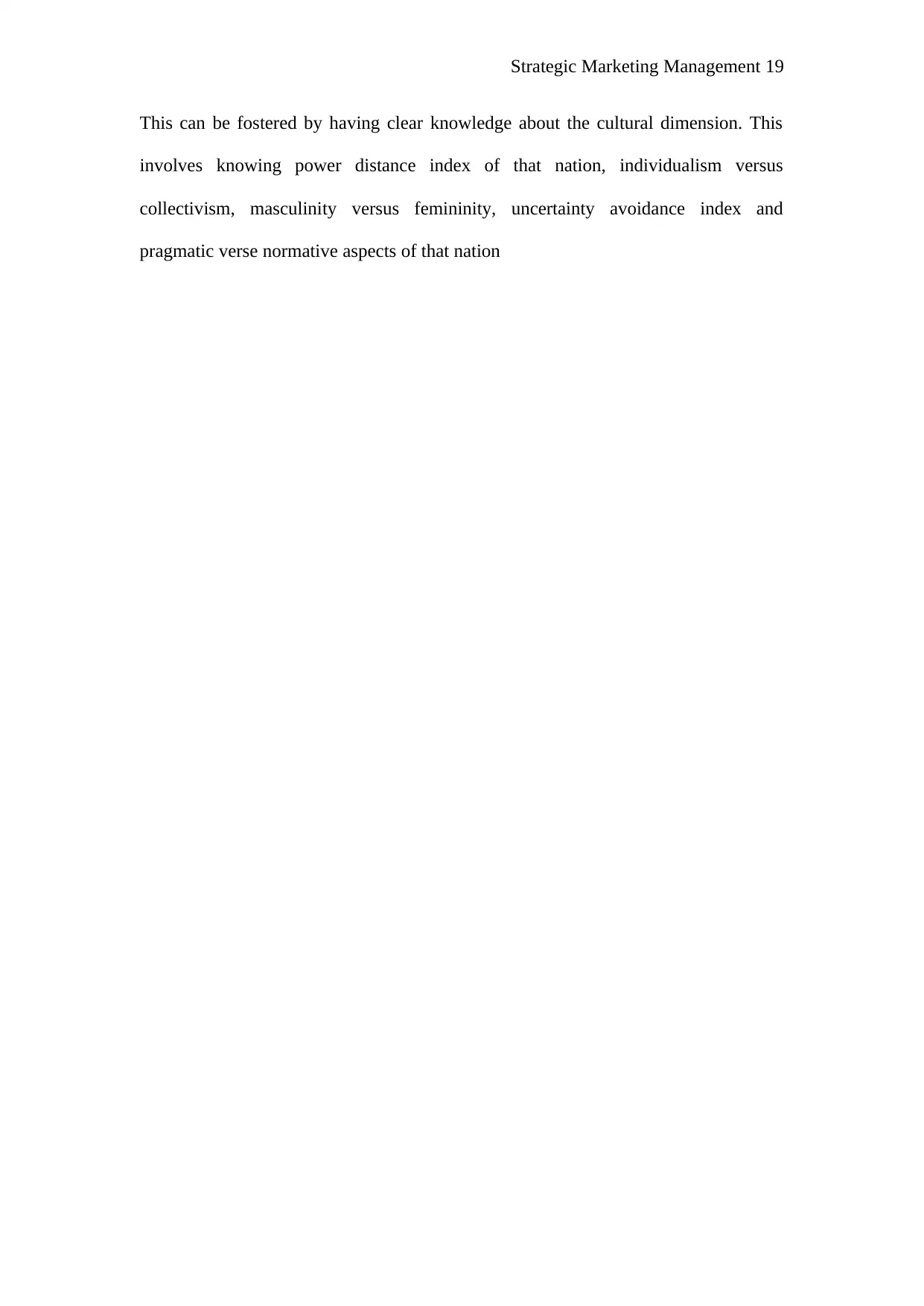
Strategic Marketing Management 19
This can be fostered by having clear knowledge about the cultural dimension. This
involves knowing power distance index of that nation, individualism versus
collectivism, masculinity versus femininity, uncertainty avoidance index and
pragmatic verse normative aspects of that nation
This can be fostered by having clear knowledge about the cultural dimension. This
involves knowing power distance index of that nation, individualism versus
collectivism, masculinity versus femininity, uncertainty avoidance index and
pragmatic verse normative aspects of that nation
Paraphrase This Document
Need a fresh take? Get an instant paraphrase of this document with our AI Paraphraser
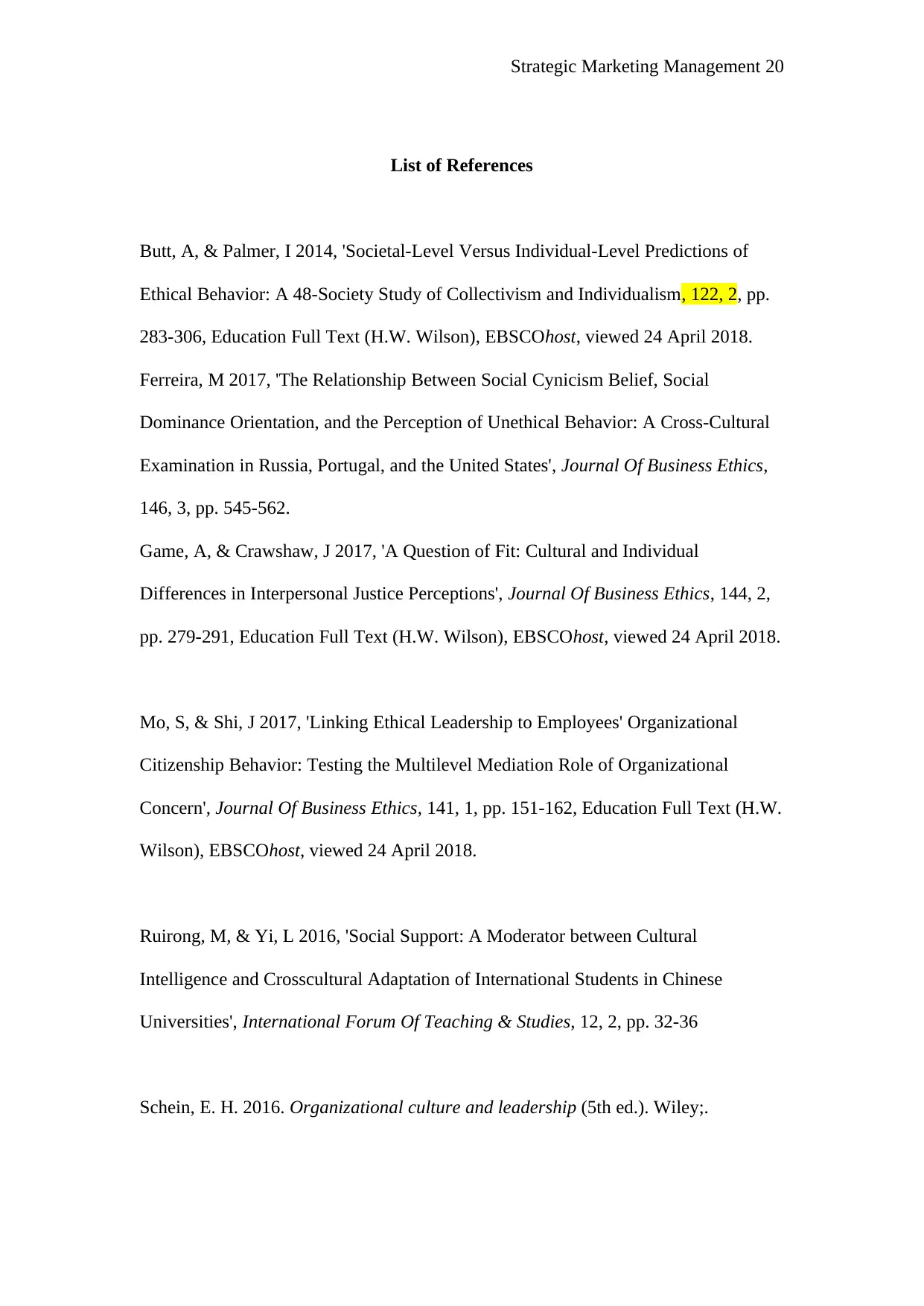
Strategic Marketing Management 20
List of References
Butt, A, & Palmer, I 2014, 'Societal-Level Versus Individual-Level Predictions of
Ethical Behavior: A 48-Society Study of Collectivism and Individualism, 122, 2, pp.
283-306, Education Full Text (H.W. Wilson), EBSCOhost, viewed 24 April 2018.
Ferreira, M 2017, 'The Relationship Between Social Cynicism Belief, Social
Dominance Orientation, and the Perception of Unethical Behavior: A Cross-Cultural
Examination in Russia, Portugal, and the United States', Journal Of Business Ethics,
146, 3, pp. 545-562.
Game, A, & Crawshaw, J 2017, 'A Question of Fit: Cultural and Individual
Differences in Interpersonal Justice Perceptions', Journal Of Business Ethics, 144, 2,
pp. 279-291, Education Full Text (H.W. Wilson), EBSCOhost, viewed 24 April 2018.
Mo, S, & Shi, J 2017, 'Linking Ethical Leadership to Employees' Organizational
Citizenship Behavior: Testing the Multilevel Mediation Role of Organizational
Concern', Journal Of Business Ethics, 141, 1, pp. 151-162, Education Full Text (H.W.
Wilson), EBSCOhost, viewed 24 April 2018.
Ruirong, M, & Yi, L 2016, 'Social Support: A Moderator between Cultural
Intelligence and Crosscultural Adaptation of International Students in Chinese
Universities', International Forum Of Teaching & Studies, 12, 2, pp. 32-36
Schein, E. H. 2016. Organizational culture and leadership (5th ed.). Wiley;.
List of References
Butt, A, & Palmer, I 2014, 'Societal-Level Versus Individual-Level Predictions of
Ethical Behavior: A 48-Society Study of Collectivism and Individualism, 122, 2, pp.
283-306, Education Full Text (H.W. Wilson), EBSCOhost, viewed 24 April 2018.
Ferreira, M 2017, 'The Relationship Between Social Cynicism Belief, Social
Dominance Orientation, and the Perception of Unethical Behavior: A Cross-Cultural
Examination in Russia, Portugal, and the United States', Journal Of Business Ethics,
146, 3, pp. 545-562.
Game, A, & Crawshaw, J 2017, 'A Question of Fit: Cultural and Individual
Differences in Interpersonal Justice Perceptions', Journal Of Business Ethics, 144, 2,
pp. 279-291, Education Full Text (H.W. Wilson), EBSCOhost, viewed 24 April 2018.
Mo, S, & Shi, J 2017, 'Linking Ethical Leadership to Employees' Organizational
Citizenship Behavior: Testing the Multilevel Mediation Role of Organizational
Concern', Journal Of Business Ethics, 141, 1, pp. 151-162, Education Full Text (H.W.
Wilson), EBSCOhost, viewed 24 April 2018.
Ruirong, M, & Yi, L 2016, 'Social Support: A Moderator between Cultural
Intelligence and Crosscultural Adaptation of International Students in Chinese
Universities', International Forum Of Teaching & Studies, 12, 2, pp. 32-36
Schein, E. H. 2016. Organizational culture and leadership (5th ed.). Wiley;.

Strategic Marketing Management 21
Schneider, S. C. 2006. National vs. corporate culture: Implications for human
resource management. Hum. Resour. Manage. 27: 231–246.
Schneider, S. C. 2006. National vs. corporate culture: Implications for human
resource management. Hum. Resour. Manage. 27: 231–246.
1 out of 21
Related Documents
Your All-in-One AI-Powered Toolkit for Academic Success.
+13062052269
info@desklib.com
Available 24*7 on WhatsApp / Email
![[object Object]](/_next/static/media/star-bottom.7253800d.svg)
Unlock your academic potential
© 2024 | Zucol Services PVT LTD | All rights reserved.





